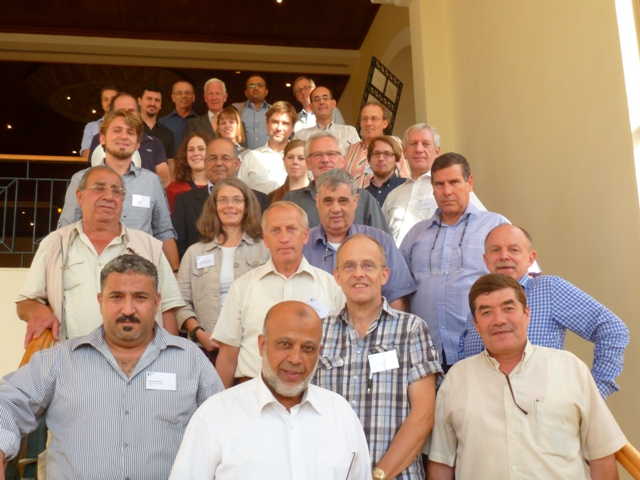
DESERVE - The Virtual Institute DEad SEa Research VEnue
The Dead Sea region faces big water-related challenges. Among them are sea level decline, desertification, flash floods, ascending brines polluting freshwater, sinkhole development, and the repeated occurrence of earthquakes. Climate change and extensive exploitation of groundwater and surface water even aggravate the situation. These challenges can be only mastered in an interdisciplinary research effort involving all riparian countries. DESERVE is designed as a cross-disciplinary and cooperative international project of the Helmholtz Centers KIT, GFZ, and UFZ with well-established partners of the riparian countries.
DESERVE is offering the unique opportunity to integrate the scientific results already achieved or presently elaborated in the Dead Sea region into a joint scientific approach based on earth, water, and environmental sciences.
DESERVE is aimed at studying coupled atmospheric, hydrological, and lithospheric processes, such as sinkholes, flash floods, and earthquakes. This interdisciplinary research approach will contribute to a sound scientific understanding of the ongoing processes. Furthermore, it enables the development of prediction models, remediation strategies, and risk assessments with respect to environmental risk, water availability, and climate change.
DESERVE is funded by the Helmholtz Association of German Research Centers.
DESERVE Special Issue online
An inter-journal open-access SI on the research results of the Virtual Helmholtz Institute DESERVE has now been published.
The SI is entitled "Environmental changes and hazards in the Dead Sea region".
The special issue is hosted at
- Natural Hazards and Earth System Sciences, NHESS
- Atmospheric Chemistry and Physics, ACP
- Hydrology and Earth System Sciences, HESS
- Solid Earth, SE
Follow the link and discover impressive findings https://www.atmos-chem-phys.net/special_issue7_915.html
News
DESERVE Kickoff Meeting
DESERVE Kickoff Meeting
The Virtual Institute DESERVE was officially launched by a kickoff meeting held at the Karlsruhe Institute of Technology on December 5 and 6, 2012. Representatives of the DESERVE partner institutions and scientific experts on the DESERVE research topics participated in the meeting. The kickoff meeting informed about the objectives and structure of DESERVE and continued to develop the DESERVE research agenda. Prof. Eberhard Umbach, President of the Karlsruhe Institute of Technology, opened the meeting. He highlighted the outstanding importance of the challenges environmental risks, water availability and climate change in the Dead Sea region, which constitute a high demand for an integrated approach of earth sciences, atmosphere and climate research as achieved with DESERVE.
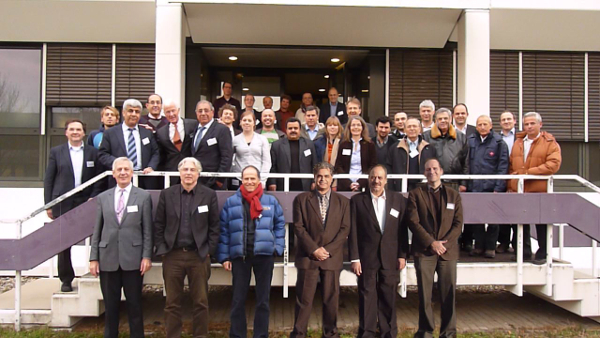
Shear-wave reflection seismic field work in Ghor Haditha
Shear-wave reflection seismic field work in Ghor Haditha
As first field campaign of work package 1 of DESERVE, a shallow seismic survey was performed between 20. October - 1. November 2013. In the area of recent sinkhole activity in Ghor Haditha (Dead Sea/Jordan) especially shear wave seismic methods were applied. This campaign was a joint effort of three partners: NRA (non-seismic investigations), LIAG (shearwave reflection seismics), and GFZ (H/V seismic spectral investigations). The field crew spent 10 days in the NRA field camp and acquired four reflection seismic profiles of 1.8 km total length to yield a high-resolution structural image of the subsurface. Environmental seismic noise measurements accompanied the active seismic experiment. First data inspection reveals subsidence and sinkhole features, as well as strong reflectors at ca. 70 m depth.
The whole team enjoyed the first geophysical field survey and looks forward to intensify this fruitful cooperation.
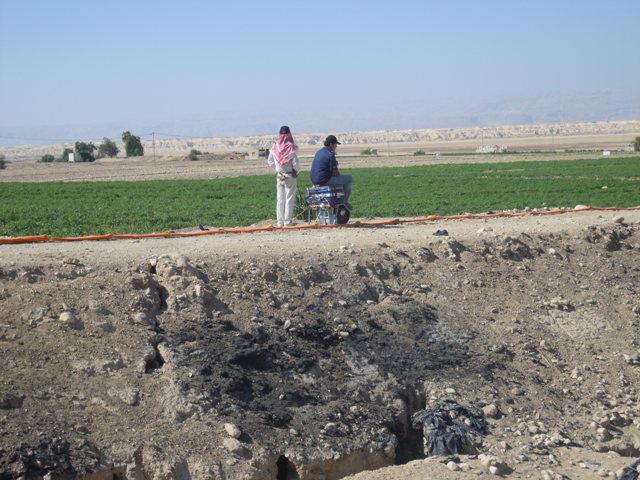
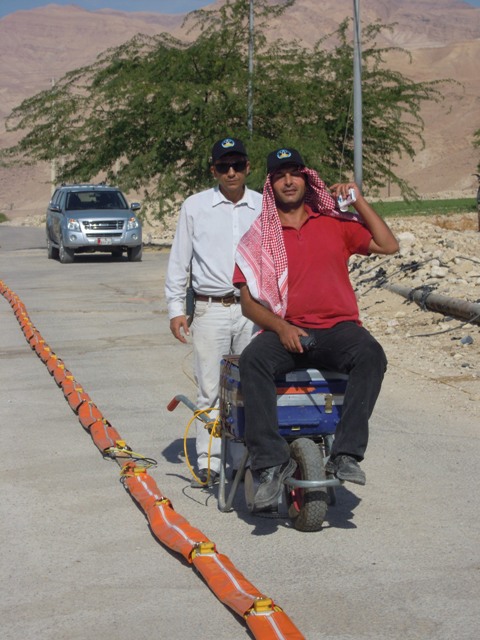
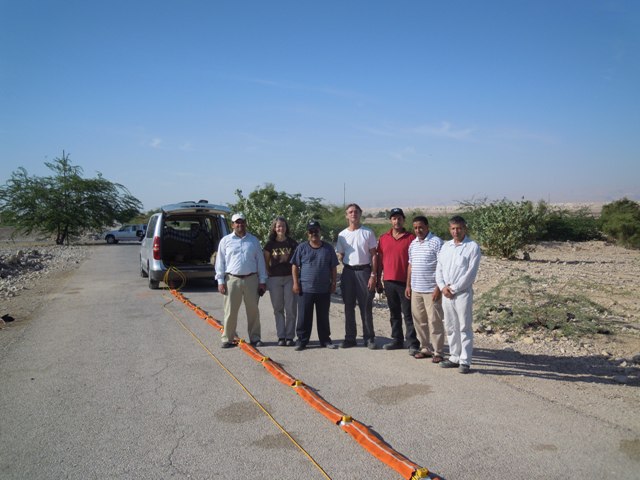
Contact: Prof. Dr. Charlotte Krawczyk
Leibniz Institute for Applied Geophysics
Section 1 - Seismics - Gravimetry - Magnetics
Stilleweg 2
30655 Hannover
Germany
charlotte krawczyk ∂does-not-exist.liag-hannover de
First DESERVE Science Progress Meeting
First DESERVE Science Progress Meeting
The First DESERVE Science Progress Meeting was held from 28 October to 30 October 2013 at the Mövenpick Resort & Spa Dead Sea, Sweimeh, Jordan. DESERVE welcomed representatives of the DESERVE partner institutions and members of external institutions.
More than 40 participants from Israel, Jordan, Germany and Palestine continued to develop the DESERVE research agenda by discussing the scientific questions addressed, by exchanging the scientific results of the first year of DESERVE and by coordinating coming research activities.
After the opening of the meeting by Prof. Christoph Kottmeier (scientific speaker of DESERVE, KIT), status quo presentations by the work package leaders informed on the current project state, as well as on the people and institutes involved.
On the second conference day, 20 talks provided an insight into the already accomplished and planned research activities related to the interacting DESERVE disciplines meteorology, hydrology and geophysics.
Group meetings on sinkholes, flash flood warning, groundwater hydrology, meteorological field campaigns, as well as on education provided a framework to focus on a particular research topic as well as to discuss and plan an event or research campaign.
The First DESERVE Science Progress Meeting clearly demonstrated the high demand for an integrated approach of earth sciences, atmosphere and climate research as achieved with DESERVE to cope with the outstanding challenges environmental risks, water availability and climate change in the Dead Sea region.
New publication: Airborne thermal data identifies groundwater discharge at the north-western coast of the Dead Sea
New publication: Airborne thermal data identifies groundwater discharge at the north-western coast of the Dead Sea
Ulf Mallast et al. identify groundwater discharge at the north-western coast of the Dead Sea by airborne thermal data.
A qualitative and quantitative monitoring of groundwater discharge was conducted based on an airborne thermal campaign undertaken along the north-western coast of the Dead Sea in January 2011 to contribute to the relatively scarce information on groundwater discharge to date in the region. The application of airborne thermal data exploits thermal contrasts that exist between discharging groundwater and background sea surface temperatures of the Dead Sea. Using these contrasts, 72 discharge sites were identified from which only 42 were known from previous in situ measurements undertaken at terrestrial springs by the Israel Hydrological Service. Six of these sites represent submarine springs and at a further 24 locations groundwater appears to seep through the sediment. Although the abundance of groundwater seepage sites suggests a significant, but so far unknown groundwater source, the main contribution appears to originate from terrestrial springs. In an attempt to provide a quantitative approach for terrestrial springs, a linear bootstrap regression model between in situ spring discharge and respective thermal discharge plumes (r2 = 0.87 p < 0.001) is developed and presented here. While the results appear promising and could potentially be applied to derive discharge values at unmonitored sites, several influence factors need to be clarified before a robust and reliable model to efficiently derive a complete quantitative picture of groundwater discharge can be proposed.
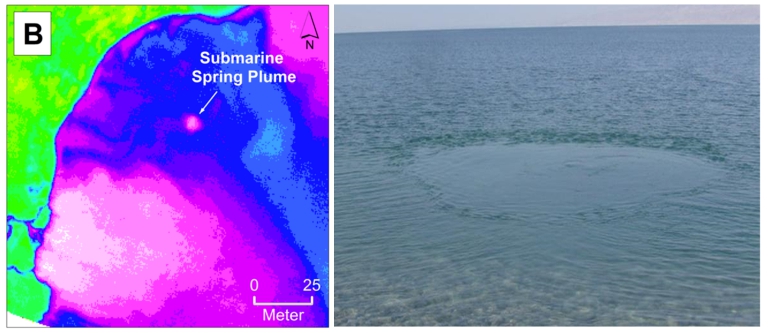
The full article is published in Remote Sensing:
Mallast, U., Schwonke, F., Gloaguen, R., Geyer, S., Sauter, M., Siebert, C., 2013, Airborne thermal data identifies groundwater discharge at the north-western coast of the Dead Sea, Remote Sensing. 5 (12), 6361-6381, doi:10.3390/rs5126361.
DESERVE field campaign „Haze and evaporation at the Dead Sea 2014“ (HEADS 2014) started
DESERVE field campaign „Haze and evaporation at the Dead Sea 2014“ (HEADS 2014) started
Evaporation is of decisive importance for the Dead Sea region. KIT starts a research programme to sample reliable data.
Firstly among other evaporation governs the Dead Sea water table and secondly it is apart from large scale advection responsible for the regional load of humidity in the air and therefore triggers weather processes (clouds, precipitation) and climate phenomena (haze, radiation) in the region. Reliable results on the evaporation in the Dead Sea valley are sparse especially evaporation estimates over the lake surface (Lensky et al., 2005).
Within DESERVE different approaches to measure and/or to calculate evaporation most reliable will be made. It was decided to establish a set of three (temporarily up to 5) stations equipped with instruments form high frequent meteorological measurements at the western coast of the Dead Sea with different distances to the shore line. Depending on the very periodical daily wind direction changes it allows according to boundary layer theory, to calculate the latent heat flux (evaporation) and the sensible heat flux over the soil surface as well as over the water body.
Sets of instruments measuring the complete energy balance of a surface with high frequency and precision where calibrated and installed (i) over bare soil, (ii) at the coastline, (iii) and within high vegetation in early 2014. Two additional stations will be operated for several months in August and September 2014.
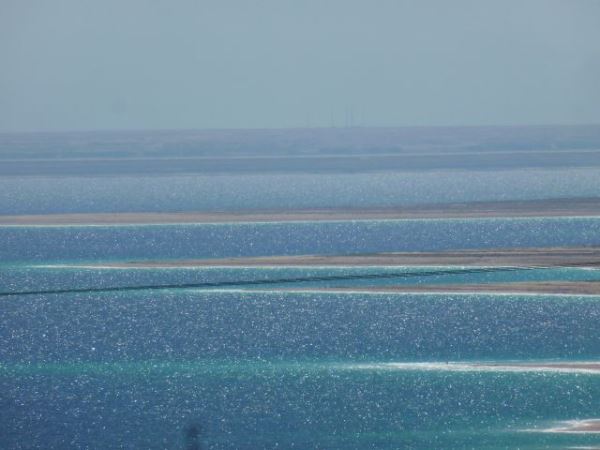
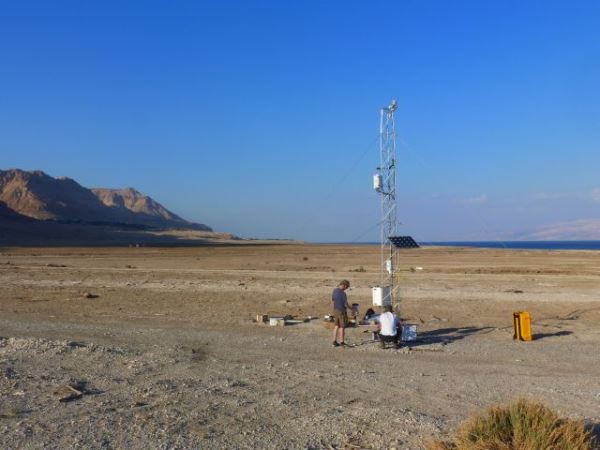
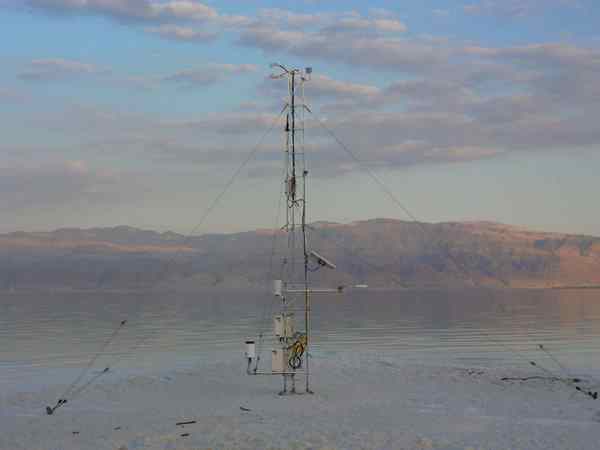
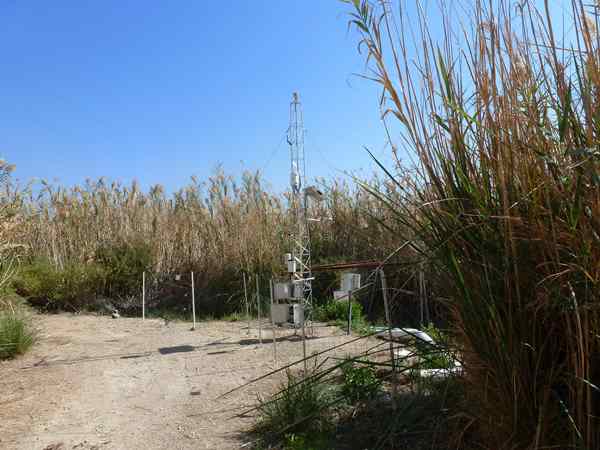
Implementation of first DESERVE meteorological station in Jordan
Implementation of first DESERVE meteorological station in Jordan
Since March 2014, the Institute for Meteorology and Climate Research -Troposphere Research (IMK-TRO) at KIT operates its first permanent meteorological station in Jordan. The station is located at the North Eastern edge of the Dead Sea mountains at a viewpoint areal hosting a restaurant and museum. The instruments installed on a 10 m mast, provide meteorological measurements of high-frequency windspeed and direction, temperature, air pressure, air humidity, soil moisture, short and long wave radiation, and precipitation.
Together with two IMK-TRO stations in Israel near Masada and at the Dead Sea coast, a network of permanent meteorological stations covering the Dead Sea region evolves.
In addition to the meteorological station a temporary seismic array is deployed at the same time in the area. It consists of 15 high frequency and broad band seismic stations provided by the Geophysical Instrument Pool (GIPP) at GFZ. The measurements aim to record meteorological parameters in seismic signals.
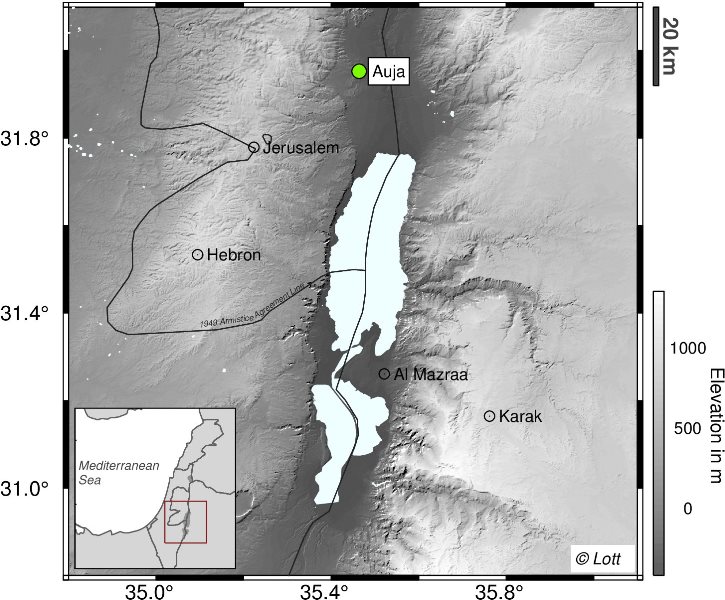
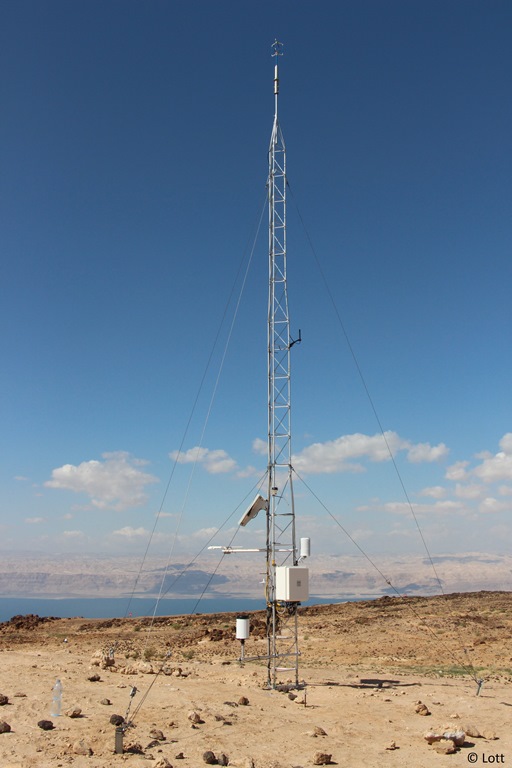
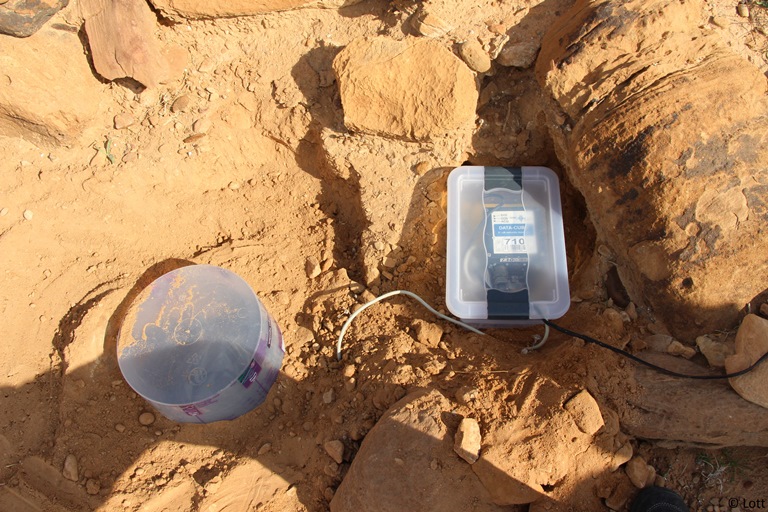
We want to thank the Royal Society for the Conservation of Nature (RSCN), especially Alaa Mujahed, for their kind cooperation making this location for measurements available. We installed the instruments in collaboration with the Natural Ressources Authority (NRA), and emphasize the commitment of the head of Jordan Seismology Observatory, Dr. Mahmoud Al-Qaryouti, who made this project possible in the first place.
Flood surges and sinkhole formation in the Wadi Ze'elim fan
Flood surges and sinkhole formation in the Wadi Ze'elim fan
In March 2014, several flood surges arose in Wadi Ze'elim fan. The Ze'elim fan opposite Mezada Mountain has recently been developing many sinkholes and the Geological Survey of Israel (GSI) is studying among others the interaction of sinkhole formation and flood waters. The Ze'elim is monitored as of this hydrological year by a new hydrometric station as part of the DESERVE WP6. Flood hydrographs have been acquired for several rises and water samples were automatically collected to determine the chemistry and suspended sediment content of the Judean Desert in this essentially unpolluted territory. It is one of several such stations in the western part of the Dead Sea incorporated into DESERVE.
A meeting this month between the relevant hydrology and climate partners (BGU, UFZ, TAU and HUJI) is part of an advanced stage of cooperation on monitoring and modelling floods and flood alert.
The video clips stress the importance of the DESERVE Virtual Institute, as they exemplify cirum-Dead Sea interactions between hydrology and geophysics (sinkholes) on the one hand, and between hydrology and climate (rainfall and runoff) on the other.
Credits: The video clips were prepared by Elad Dente (HUJI) and Dr. Nadav Lensky and Dr. Gidi Bar (GSI).
© Jonathan Laronne (BGU)
KITcube arrived at Masada to investigate „Haze and evaporation at the Dead Sea 2014“ (HEADS 2014)
KITcube arrived at Masada to investigate „Haze and evaporation at the Dead Sea 2014“ (HEADS 2014)
With KITcube, the Institute for Meteorology and Climate Research at the Karlsruhe Institute of Technology arrived at the Dead Sea with an excellent equipment of modern measurement instruments for experimental studies of the atmosphere.
The KITcube is an overall monitoring system that consists of different instruments to probe the atmosphere. It can survey an atmospheric volume of about 10 km side length with different methods and thus allows the temporally and spatially complete capturing of all relevant processes. In the past, the instruments for ground-based remote sensing of the atmosphere (lidar) and the instruments for in-situ measurements (turbulence, radiation, measurement towers) have been used in large international field programs worldwide.
During HEADS 2014, the KITcube will investigate evaporation within the valley of the Dead Sea with special emphasis on the evaporation from the open Dead Sea water surface by long term eddy correlation measurements. Additionally, the formation and the life cycle of haze in the Dead Sea valley by four-dimensional measurements of flow and stability within the Dead Sea valley will be investigated. The measurement will be performed during the dry and the wet season at Masada (Israel) and different locations in Jordan.
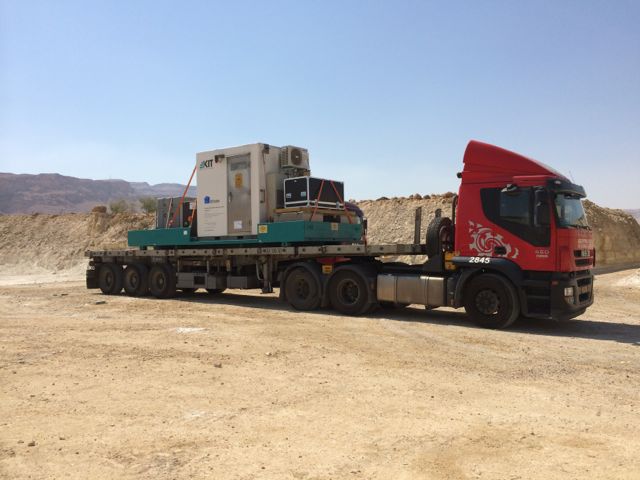
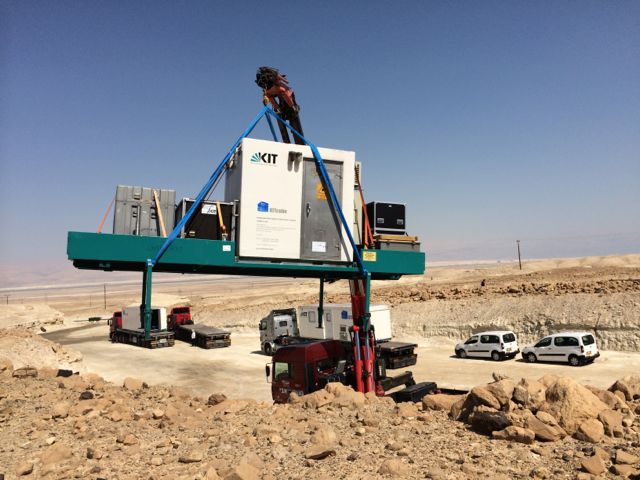
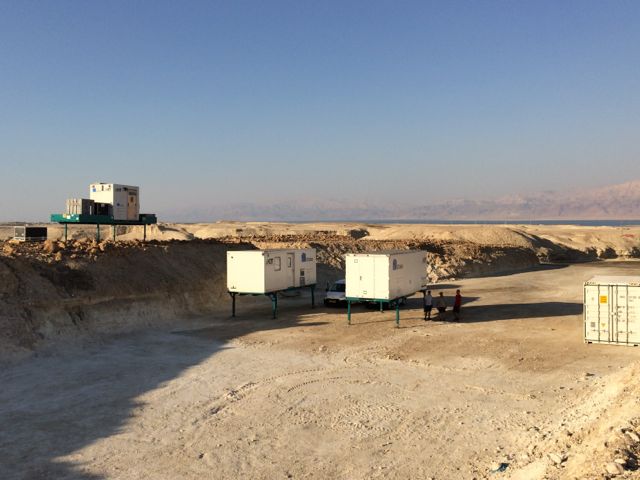
KITcube measurements successfully started
KITcube measurements successfully started
Since the beginning of August, the KITcube observatory is measuring at the opera site at Masada (Israel) under the supervision of the Institute for Meteorology and Climate Research - Troposphere Research of the Karlsruhe Institute of Technology (KIT, Germany) and Tel Aviv University (TAU, Israel). In parallel, two energy balance stations are installed at the Jordanian Dead Sea coast. Thanks to the constant effort of all partners involved, all instruments are running smoothly after some initial challenges were overcome. Part of the data is already available online, e.g. the sun photometer which is part of AERONET.
The current measurements are further intensified by special observation periods (SOPs) during weekends. Every two hours, radiosondes recording temperature, relative humidity, wind direction, and wind velocity are launched up to 20000 meters at the Israeli and Jordanian coast of the Dead Sea simultaneously.
Through the combined measurements meteorological phenomena such as regional wind systems as well as the Dead Sea haze can be investigated in depth. Especially, cloud and precipitation formation, the energy budget of soil and water surfaces, and flow dynamics are key processes for the water cycle and its variability. The role of aerosols in modifying clouds and precipitation and in developing the Dead Sea haze layer is one of the most intriguing questions. The haze influences visibility, solar radiation, and evaporation, and thereby also affects economy and health.
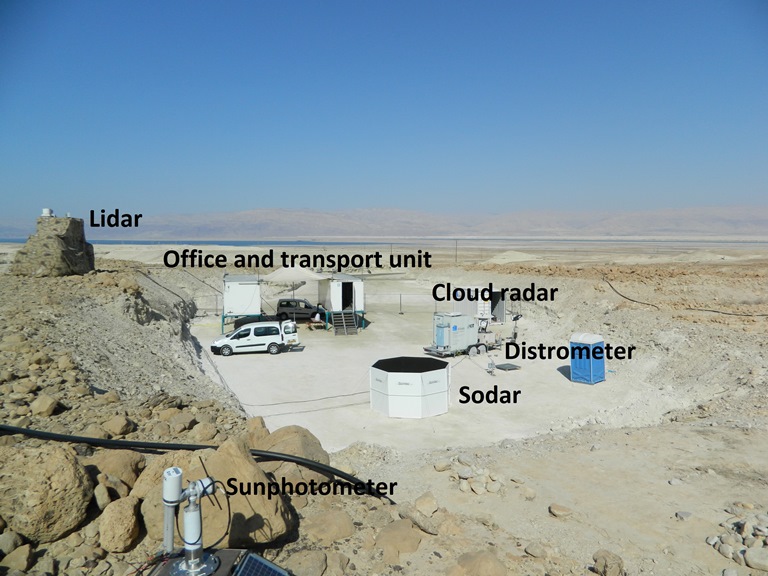
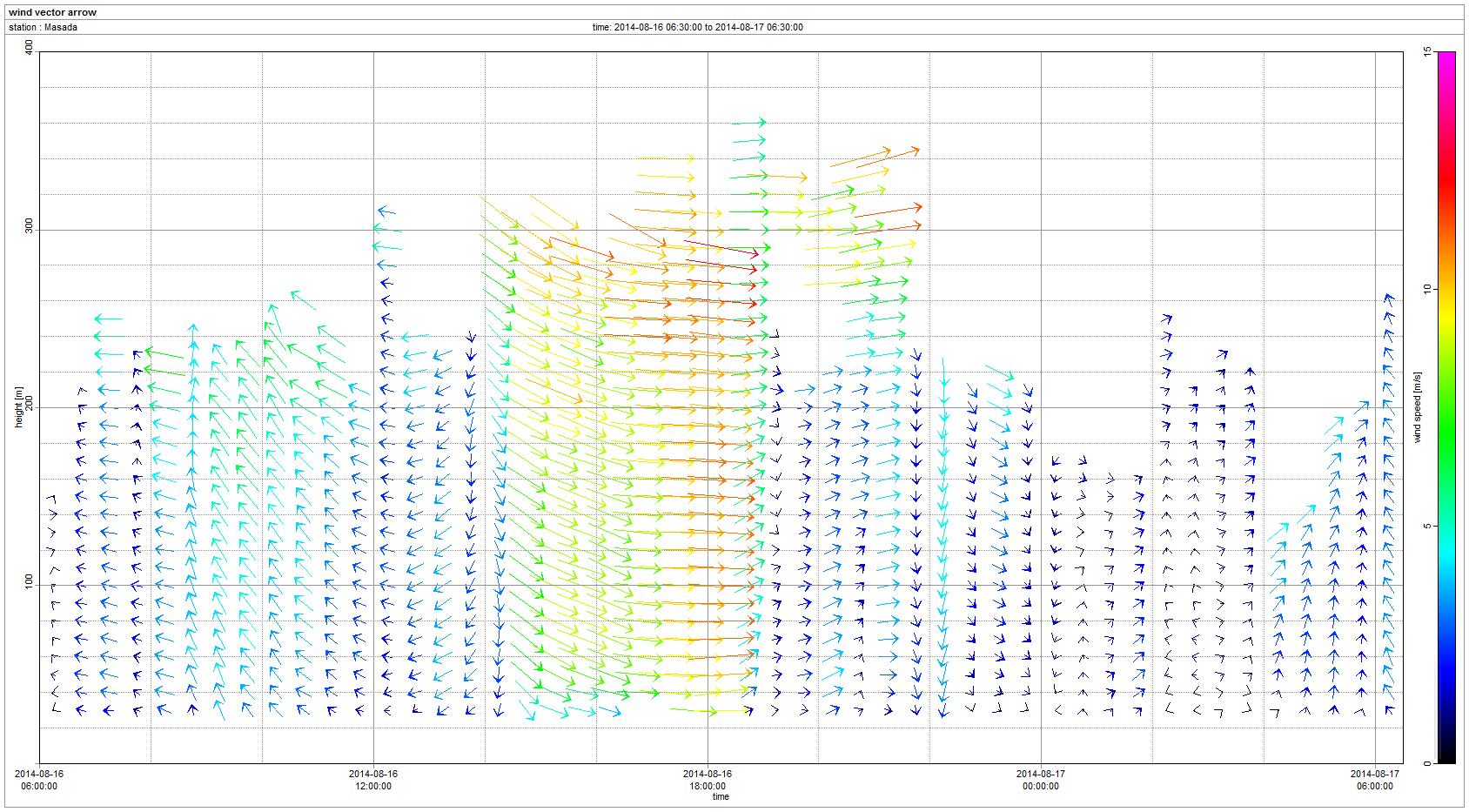
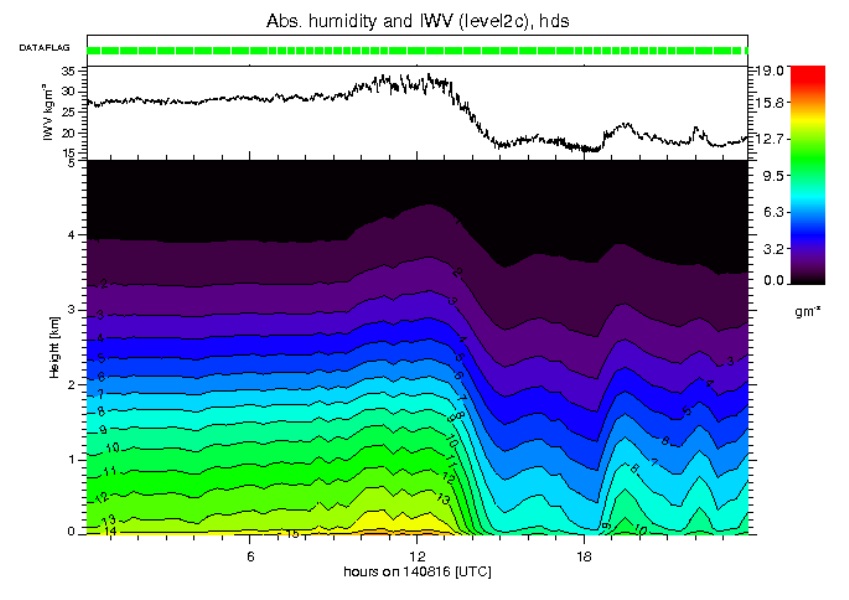
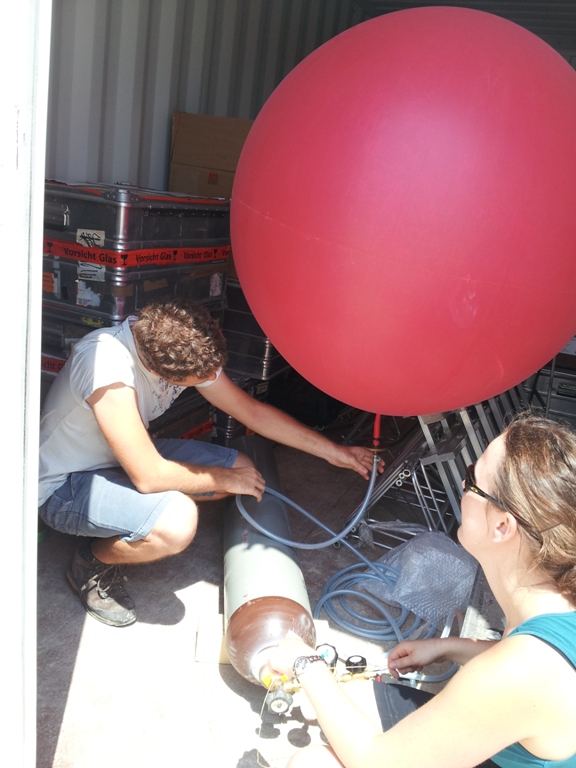
In the coming days, we look forward to the arrival of collaborating researchers conducting their own experiments in parallel to the KITcube measurements. The KITcube measurements will enable them to better interpret their own measurements. The KITcube summer campaign will continue until mid-September and will be complemented by a winter campaign in November/December this year.
Last but not least, we would like to express our sincere thanks to all individuals and institutions involved for making endless efforts and spending time to implement and execute the KITcube measurements and all related tasks.
Second field campaign on sinkholes in Ghor Haditha successfully completed
Second field campaign on sinkholes in Ghor Haditha successfully completed
For the second time, field measurements were carried out successfully in the sinkhole area of Ghor Haditha, Jordan, in the framework of WP1 of DESERVE from 12th to 26th October 2014. German scientists from the German Research Centre for Geosciences, GFZ (Potsdam) and the Leibniz Institute for Applied Geophysics, LIAG (Hannover) as well as Jordanian partners from the Natural Resources Authority, NRA (Amman), part of the Jordanian Ministry of Energy and Mineral Resources, performed a collaborative joint fieldwork at the South-Eastern part of the Dead Sea.
During the two weeks, geophysical methods were applied to assess the subsurface structure of the sinkhole affected areas via S-wave reflection Seismics and Georadar studies. Several seismic profiles of the survey in 2013 could be repeated and extended and additional new profiles were measured. The aim of the repeated lines is to observe changes in time of the subsurface structures up to depths of 300 m as the area is evolving on a highly dynamic and rapid scale. The Georadar, with antennas of 50 and 100 Mhz, was used to complete the studies in the superficial subsurface along several profiles. Additionally a subsided area with a cavity expected beneath and possible future sinkhole development was surveyed in 3D.
For assessing sinkhole distribution, structural features and local land forming and hydrological conditions an aerial survey with a Helikite Balloon was performed in both the alluvium fan deposit areas and farmlands as well as on the mudflats recently abandoned by the Dead Sea water. For this purpose marker points had to be set up in the whole area and measured with a high precision differential GPS. High quality impressive images from 150 m altitude could be obtained by this method. A digital elevation model will be developed with the help of this data. Changes in the area will be documented in future using drone and further balloon surveys.
At the end of this highly productive fieldwork the German partners were able to attend a conference on geophysical techniques and visit the institution of NRA in Amman. Thanks to all people involved that made this fieldwork a great success!
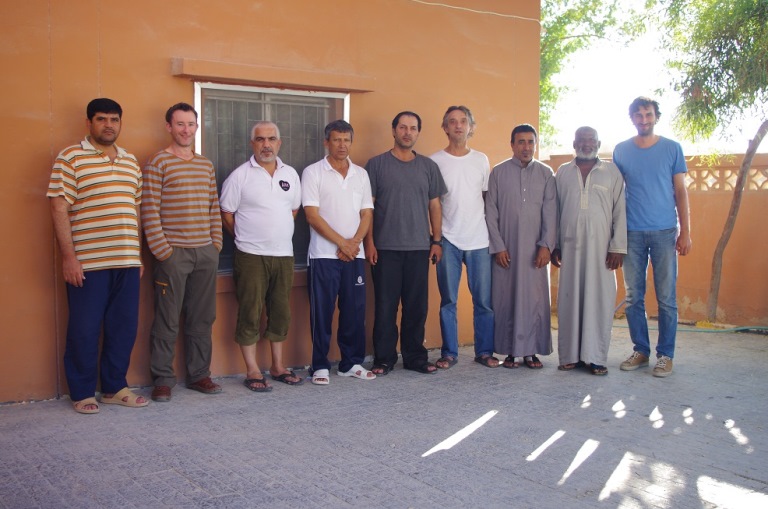
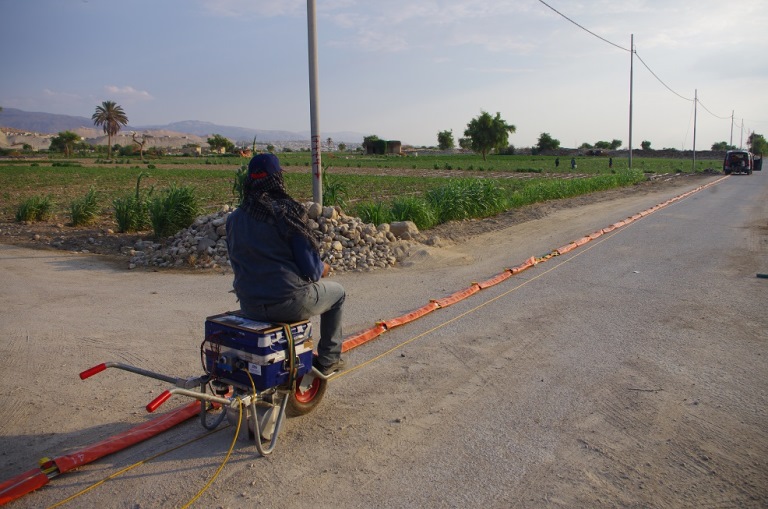
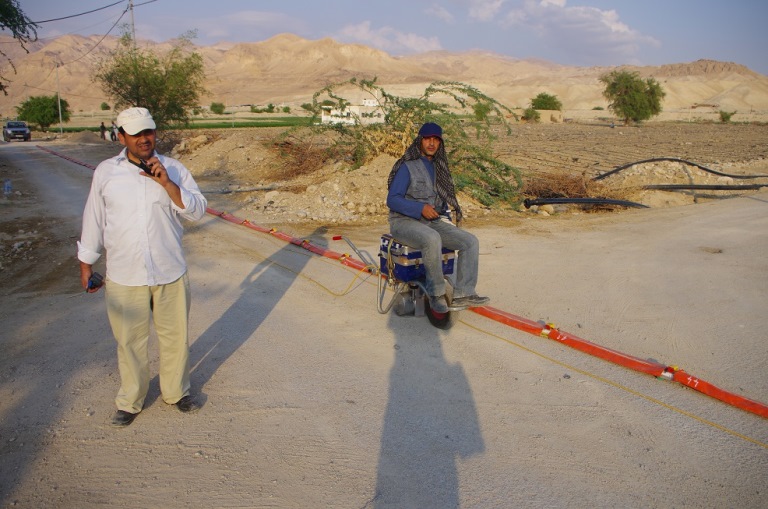
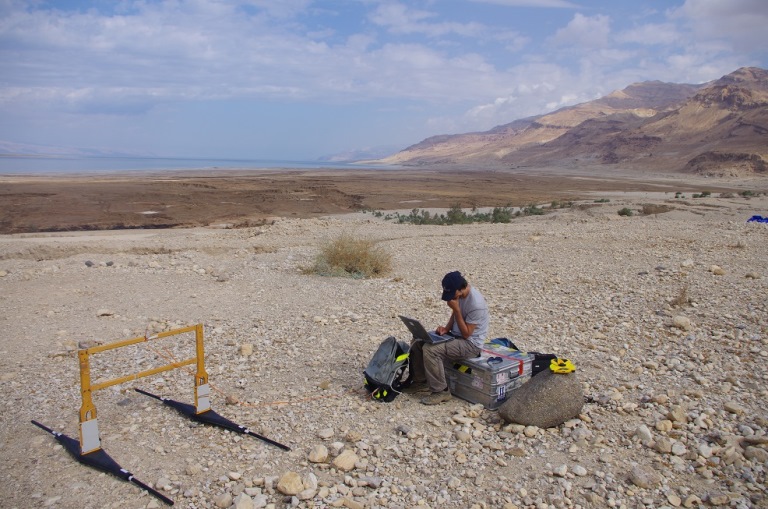
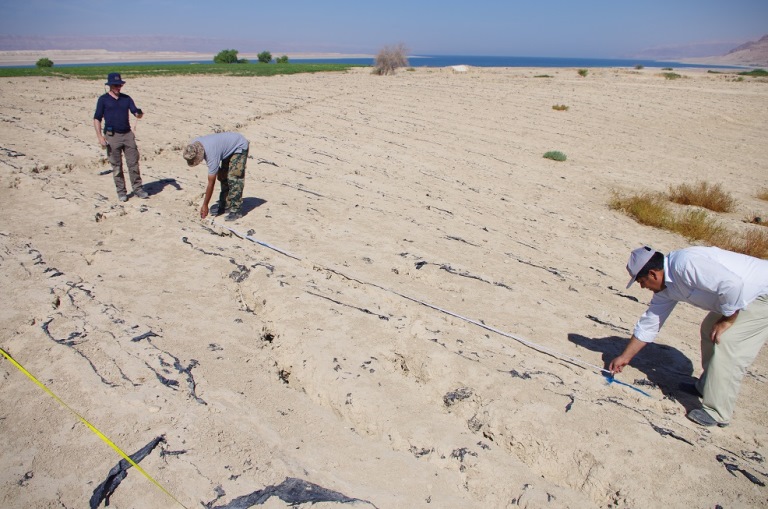
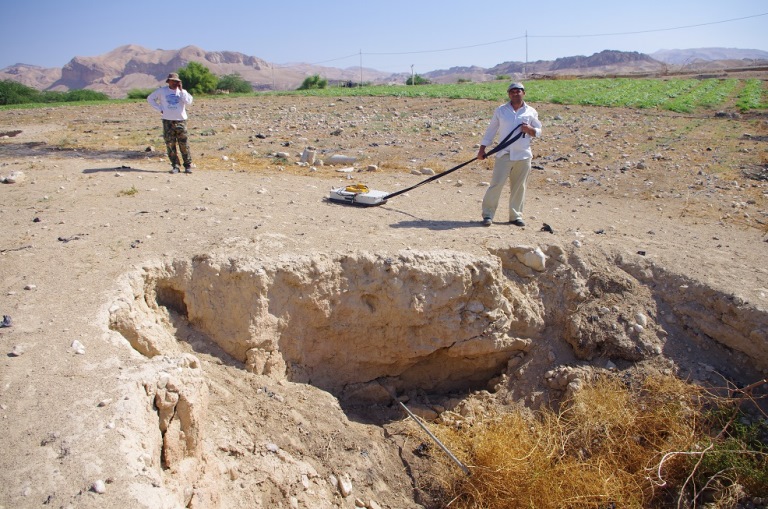
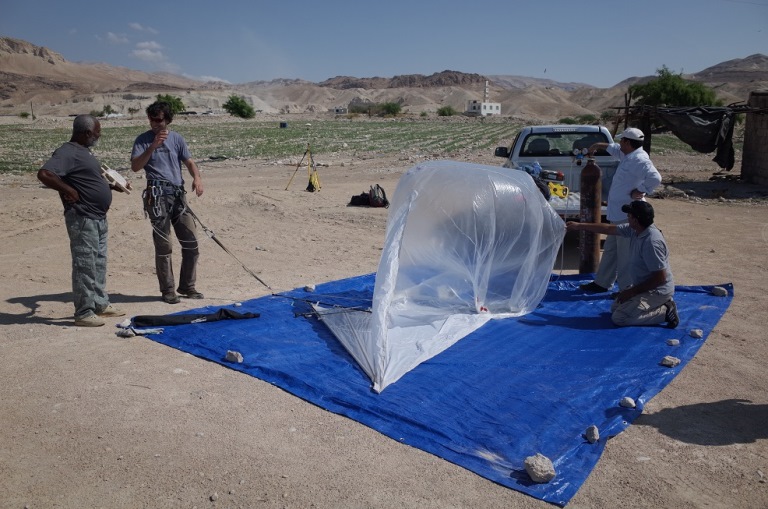
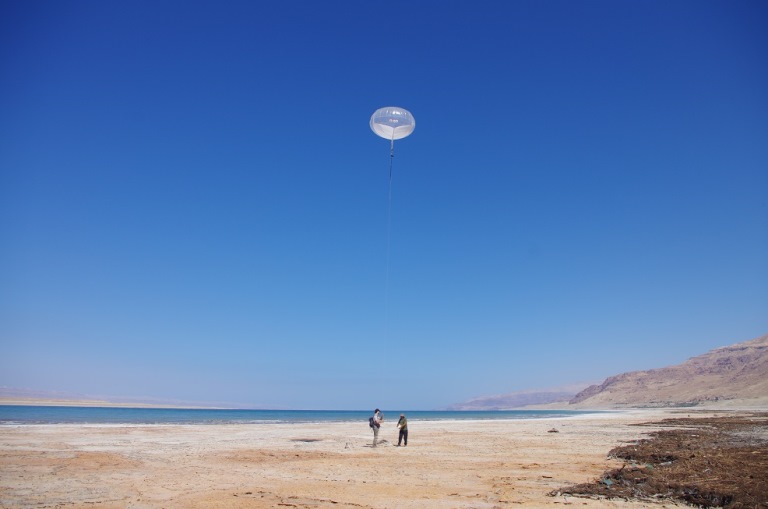
Sunny when it rains
Sunny when it rains
Masada, Israel, 31. October 2014: Right for the start of the 2nd phase of HEADS measurement campaign „wet season“ rain came up over the KITcube measurement site in the Judean Desert.
The integrated atmospheric observation system KITcube was re-installed at the Masada Opera Area by a team of six engineers and scientists of IMK-TRO by end of October 2014. After a very successful 1st phase of the HEADS campaign during August this year covering the conditions of the dry season in the Dead Sea rift valley the measurements for the wet season started.
Main aims of the measurements are the investigation of local wind systems as well as haze and evaporation in the valley. Evaporation, clouds and precipitation are key processes for the water cycle and its variability.
The role of aerosols on the formation of clouds and the development of the Dead Sea haze layer is one of the questions scientists of IMK-TRO, together with their partners want to investigate. Part of the data is already available online as part of the AERONET network.

Contact
| Jutta Metzger Karlsruhe Institute of Technology (KIT) Institute for Meteorology and Climate Research - Troposphere Research Hermann-von-Helmholtz-Platz 1 76344 Eggenstein-Leopoldshafen Germany Phone: +49 721 608-28060 Email: jutta metzger ∂does-not-exist.kit edu |
Andreas Wieser Karlsruhe Institute of Technology (KIT) Institute for Meteorology and Climate Research - Troposphere Research Hermann-von-Helmholtz-Platz 1 76344 Eggenstein-Leopoldshafen Germany Phone: +49 721 608-22841 Email: andreas wieser ∂does-not-exist.kit edu |
Implementation of first DESERVE meteorological station in Palestine
Implementation of first DESERVE meteorological station in Palestine
Since 11 November 2014, the Institute for Meteorology and Climate Research -Troposphere Research (IMK-TRO) at KIT operates its first permanent meteorological station in Palestine. The station is located at Uja in the Jordan Valley in close vicinity to the DESERVE seismological station. The instruments installed on a 10 m mast, provide meteorological measurements of high-frequency wind speed and direction, temperature, air pressure, air humidity, soil moisture, soil temperature, short and long wave radiation, and precipitation.
Together with several IMK-TRO stations in Israel as well as one IMK-TRO station in Jordan, a network of permanent meteorological stations covering the Dead Sea region evolves.

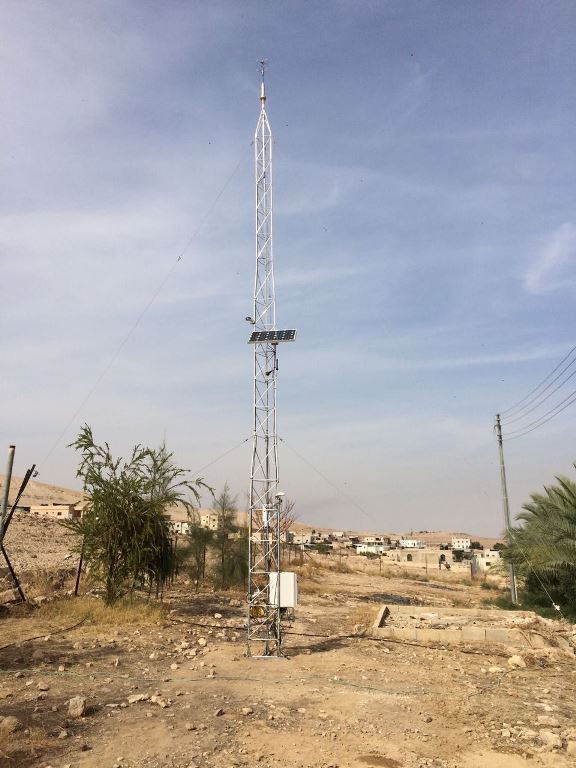
We want to thank Dr. Ayman Mohsen from the German Research Centre for Geosciences, GFZ (Potsdam), who made this project possible in the first place, as well as Uja Municipality for their kind cooperation making the location for measurements available.
The highlight of 2014: First DESERVE Winter School
The highlight of 2014: First DESERVE Winter School
The Dead Sea Research Venue hosted the first DESERVE Winter School at Masada, Israel from 24 November to 5 December 2014. At temperatures still above 20°C, DESERVE welcomed 25 students from universities, and research institutions, in particular Master and PhD students, with manifold educational background ranging from geophysics to hydrology and meteorology and common interest in the Dead Sea region.
The Winter School was opened by a science slam. Each participant presented his/her research in an entertaining way, only with the help of a self-drawn picture. There was a lot of laughter.
After two introductory days on the geology, climate, biology, and economy of the region, the Winter School focused on hydrological and meteorological aspects of the Dead Sea region. Internationally recognized researchers of DESERVE and invited experts hold lectures on e.g. rainfall runoff processes, the energy balance of the region, convection as well as hydrochemistry. The lectures were accompanied by exercises and field days.
The Winter School was closed by a farewell party lasting until sunrise.
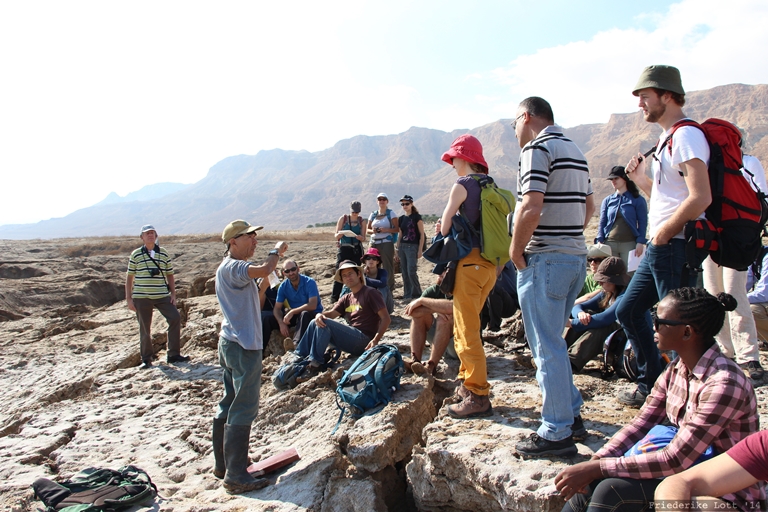
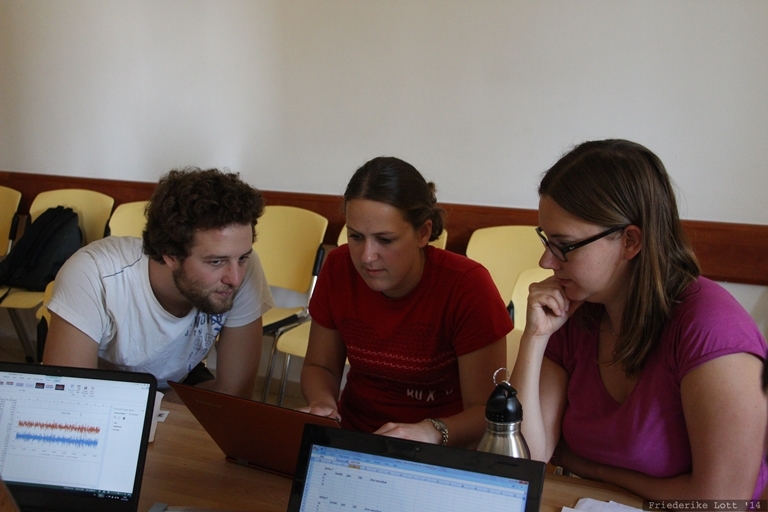
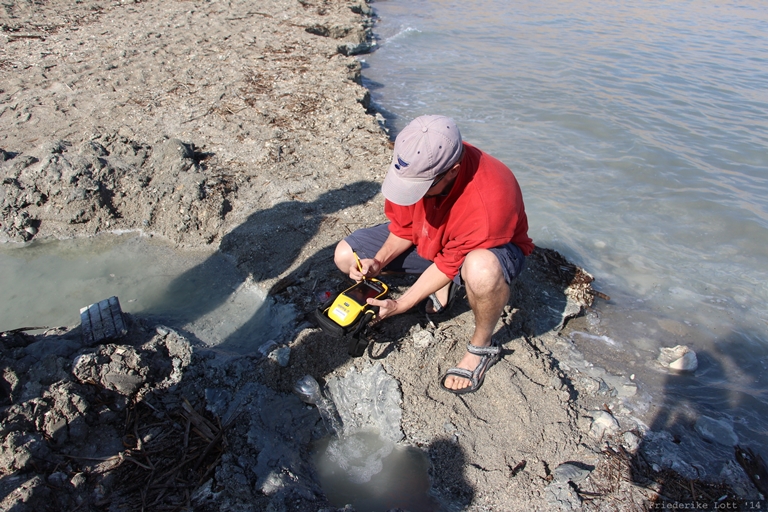
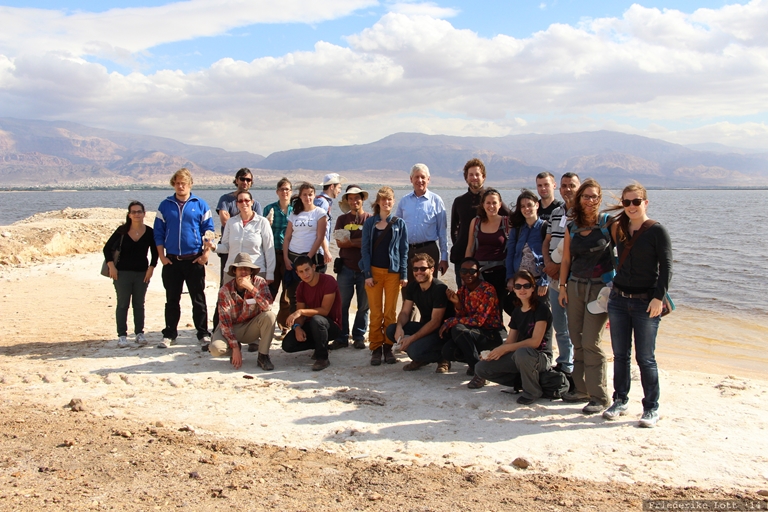
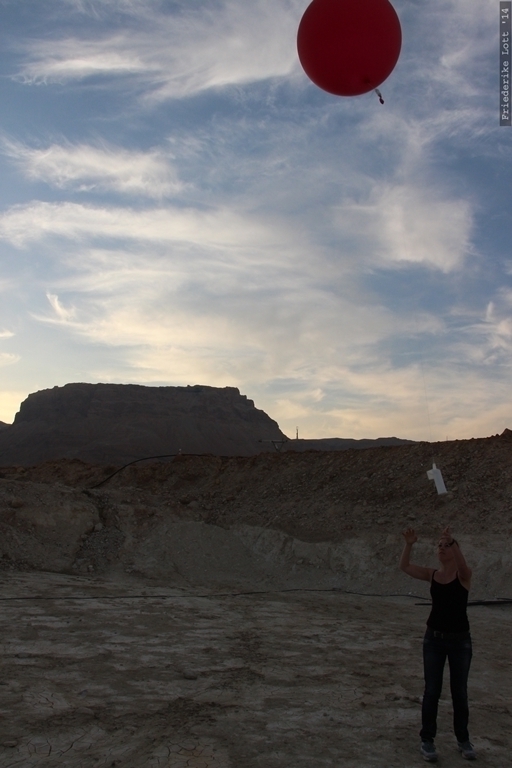
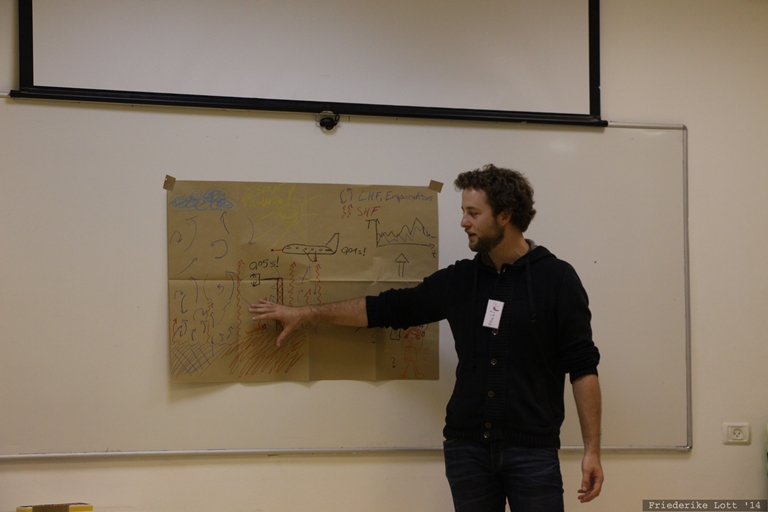
The participants’ feedback was very positive. DESERVE is pleased that the Winter School brought forward their research as well as contributed to the scientific exchange within and among the different disciplines. There was a great atmosphere among the students. They enjoyed their stay, had a lot of fun and made new friends.
“I wanted to thank you for letting me take part in the DESERVE Winter School. It was very interesting, I learned a lot and at the same time I met nice people from around the world. Also, I wanted to say that the organization and planning of the winter school was WUNDERBAR and I wanted to thank you again for the experience I've experienced.”(Feedback of one participant)
DESERVE would like to thank all lecturers for sharing their knowledge and experience. An event like the Winter School would not be possible without their support. A special thanks goes to the motivated participants of the DESERVE Winter School. Thank you very much for your participation and your active contribution in this event. It was a great pleasure to host you at Masada.
DESERVE is looking forward to meeting all participants again in the framework of DESERVE. The second DESERVE Winter School will focus on the solid earth processes in the Dead Sea region and will take place in 2016.
Field campaign on sinkholes (WP1) and submarine springs (WP2) along the coast around Wadi Darga (Deragot)
Field campaign on sinkholes (WP1) and submarine springs (WP2) along the coast around Wadi Darga (Deragot)
Under the lead of scientists from the Helmholtz Centre for Environmental Research (UFZ) a 14-day field campaign in 11/2014 was pursued located north and south of the outlet of Wadi Darga (Deragot). During the campaign two aspects were in focus serving WP1 (Sinkholes) and WP2 (Water budget components).
The first focus was set on submarine springs as the, to date, quantitatively unassessed component of the Dead Sea water budget. The foreseen quantification approach requires detailed and small scale physical data that need to be obtained in-situ or near in-situ. By these means, UFZ scientists cooperated with scientists from the Scientific Diving Centre at TU Bergakademie Freiberg and the company EvoLogics GmbH Berlin for the reason to 1) investigate and map in-situ the distribution and dimension of submarine springs through divers and additionally to sample the spring-water in order to attribute the spring outlet to the respective source aquifer, 2) map the sea-floor / water depths with a 0.5x0.5 m spatial resolution using an echosounder and a sidescan sonar mounted onboard an autonomously operating USV (unmanned surface vehicle), called Sonobot. First results reveal the expected congruence between the sea-floor mapping of the divers and the USV enabling us to effectively scan larger areas with the required level of detail. It furthermore shows indications to allow the derivation of 3D information of the shape of the buoyancy-driven jet within the water column that is generated by the outflow of the fresh- or brackish submarine springs. That ability would largely increase the chance to model the outflow, distribution and diffusion processes within the water column up to the sea-surface.
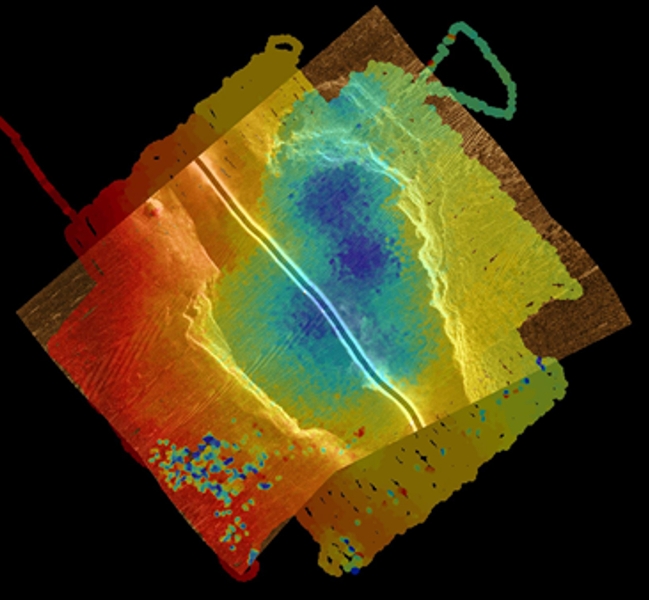
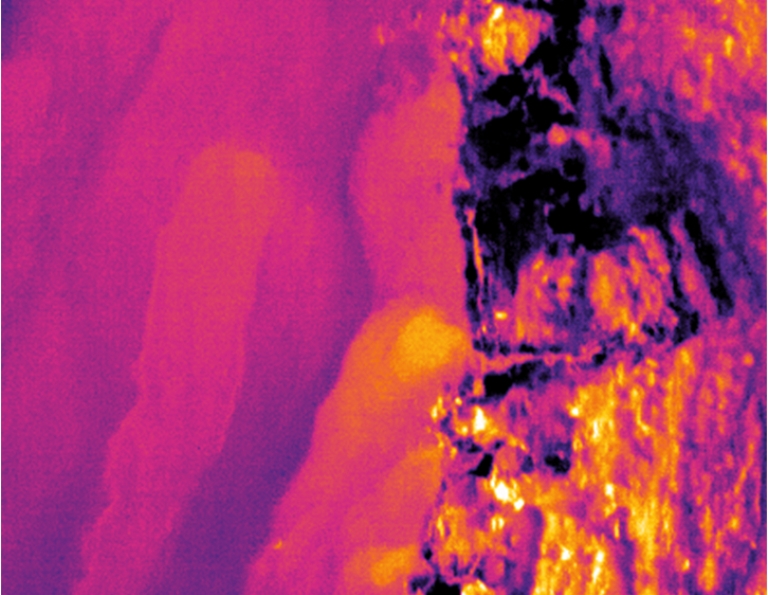
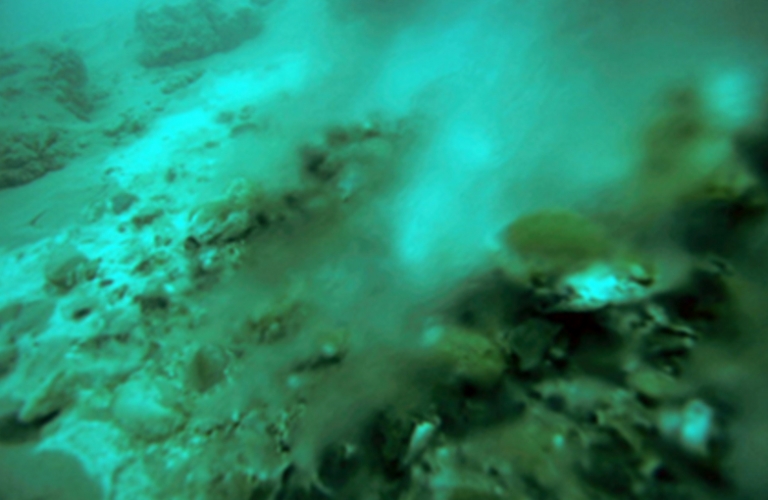
In order to combine those near in-situ information we furthermore applied a complementary airborne approach using a thermal system mounted onboard an UAV (unmanned aerial vehicle), called GeoX-8000. Submarine springs, differing in temperature from the ambient Dead Sea water, have a distinct thermal signature (pattern) at the sea-surface. We use this signature to localize discharge location, and perspectively, relate its shape and the ∆T (between water at the spring outlet and at the sea-surface) to the volumetric submarine groundwater discharge. The combination of all aided by planned small scale and long term hydrochemical investigations will converge within a model that allows us to predict the submarine discharge at the Dead Sea.
The second focus was set on sinkholes. In a complementary approach to the one conducted some weeks earlier at Ghor Hadditah the Geox-8000 was used to record the Mineral Beach sinkhole site. Within 10:20 min flight time and at a flight altitude of 50m, 500 images were recorded from which a high resolution digital elevation model (spatial resolution < 5cm) is calculated that serves as basis for future campaigns to monitor the subsidence over time at this site.
All this field work would not have been possible with the help of several people including Eldad Hazan (National Park Authority, Head of Enot Zukim reserve), Dr. Yossi Yechieli (Geological Survey of Israel), Assaf Tsabar (Dead Sea Works), Jake Ben Zaken (Kibbutz Ein Gedi), Mandy Hoyer, Dr. Thomas Pohl, Prof. Broder Merkel (all TU Bergakademie Freiberg), Thomas Tietz and Jevgeni Glushko (EvoLogics GmbH), thank you all for your efforts that made the campaign joy- and successful.
Contact
| Dr. Ulf Mallast Helmholtz-Zentrum für Umweltforschung, UFZ Dept. Grundwassersanierung Theodor-Lieser-Straße 4 06120 Halle/Saale Germany Phone: +49-345-558-5210 Email: ulf mallast ∂does-not-exist.ufz de |
Dr. Christian Siebert Helmholtz-Zentrum für Umweltforschung, UFZ Dept. Catchment Hydrology Theodor-Lieser-Straße 4 06120 Halle/Saale Germany Phone: +49-345-558-5211 Email: christian siebert ∂does-not-exist.ufz de |
The Dead Sea is shrinking
The Dead Sea is shrinking
The lowering of the Dead Sea lake level resulting in a shift-back of the Dead Sea shoreline has a direct impact on tourism at the Dead Sea. Every couple of months, the beaches infrastructure (showers, lifeguards …) has to be moved several meters in the direction of the receding shoreline. The meteorological measurements of DESERVE are affected by the shift-back of the Dead Sea shoreline too. Since March 2014, the Karlsruhe Institute of Technology is operating an energy balance station at the Dead Sea to measure the evaporation of the Dead Sea water body. The measurements are based on the eddy covariance technique, with which the water vapour flux can be measured directly.
In February 2014 the energy balance station was erected directly at the shoreline. Temporarily, the station was even flooded. However, the Dead Sea is continuously shrinking. The average annual drop of the water level is 1.1 m. In August 2014, the Dead Sea level dropped by 13 cm, and reached the level of -428.47 m on 1/9/2014 (Hydrology Institute Report published on Sept. 1st 2014). As a result, the energy balance station was about 40 meters away from the shore line in April 2015.
For this reason, the station had to be moved by 40 meters to the shoreline in April 2015 by a team of the Karlsruhe Institute of Technology.
Timeline
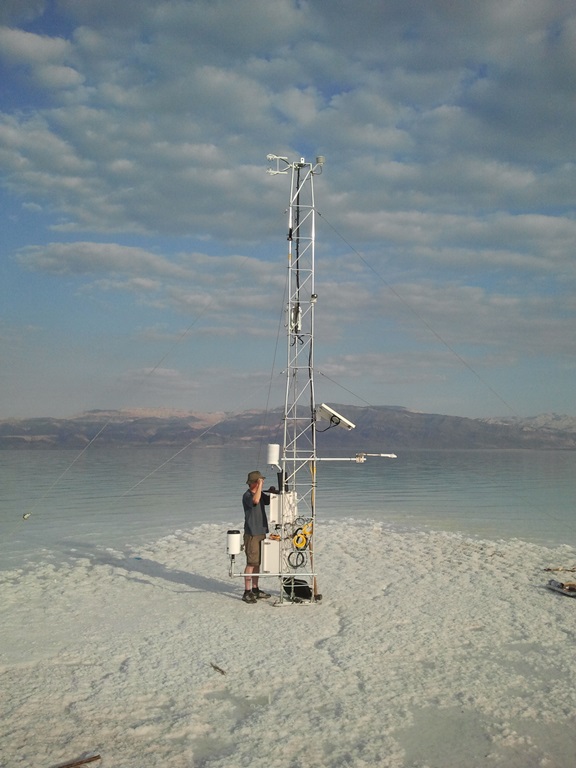
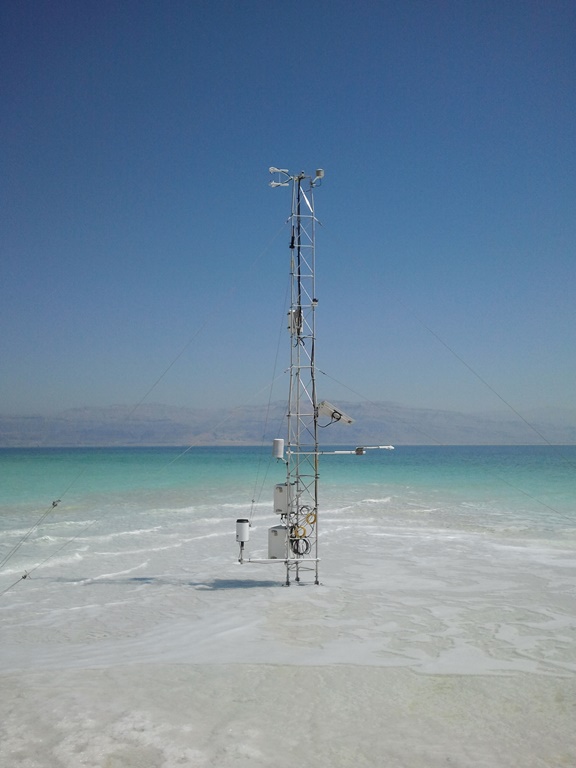
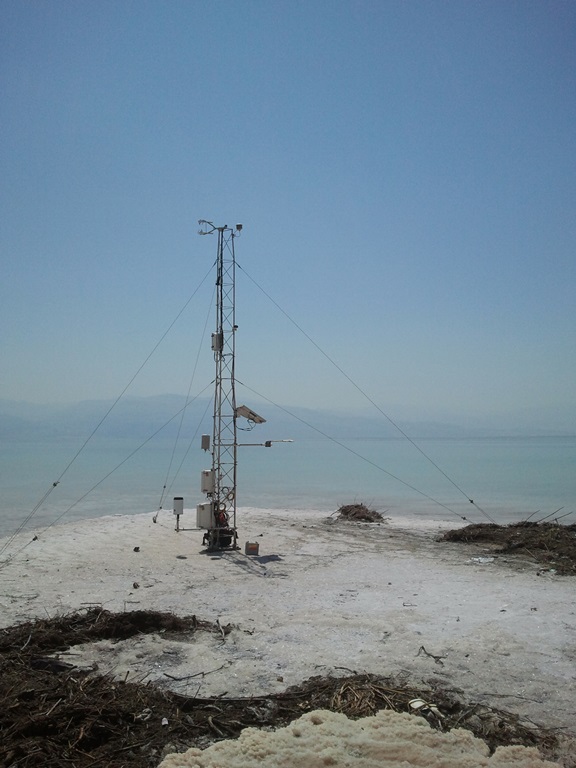
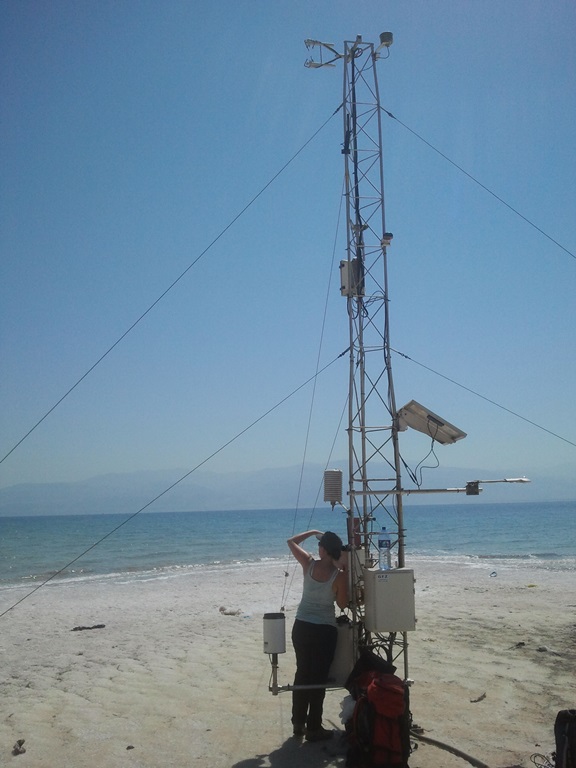
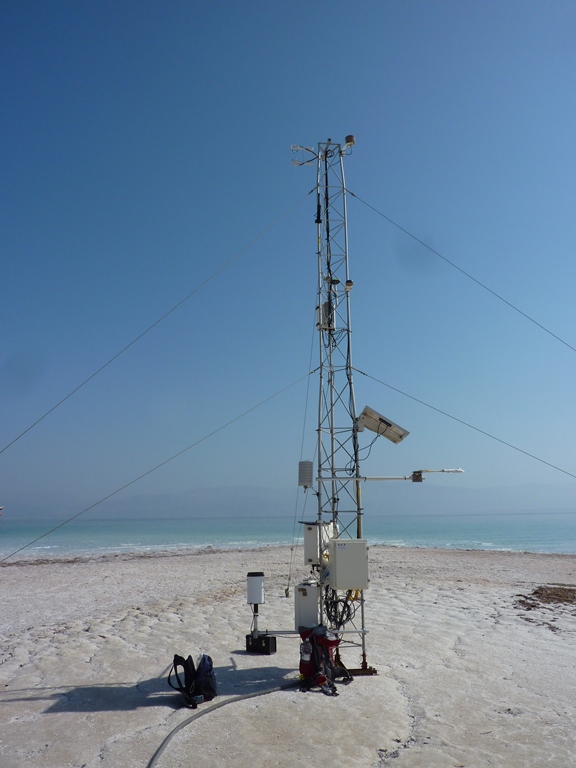
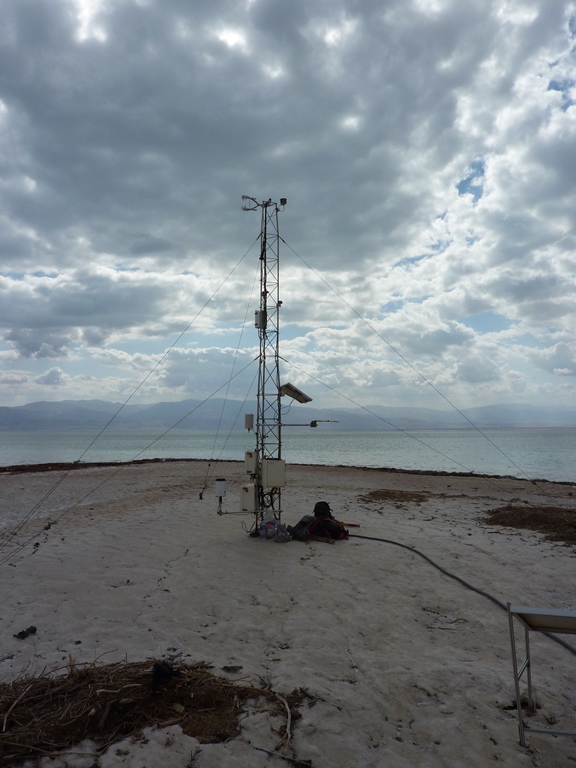
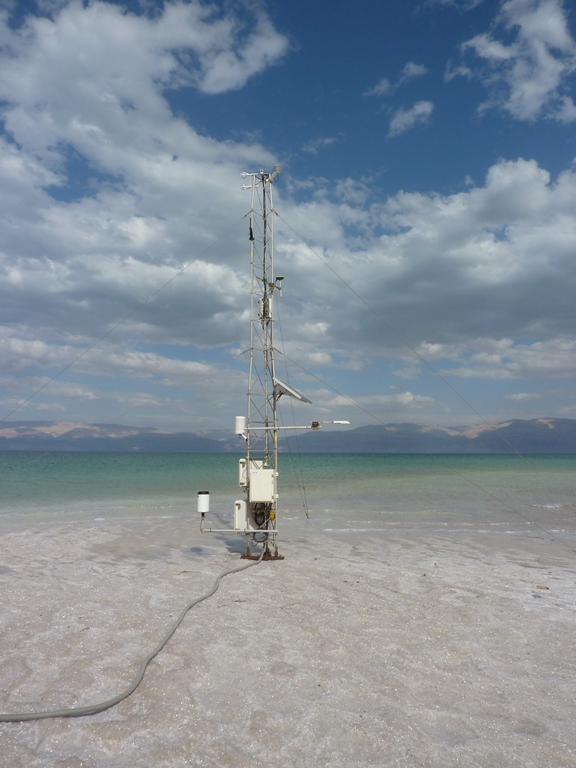
Second DESERVE Science Progress Meeting
Second DESERVE Science Progress Meeting
The Second DESERVE Science Progress Meeting was held from 4 May to 6 May 2015 at the German Research Centre for Geosciences (GFZ), Potsdam, Germany. DESERVE welcomed 40 representatives of the DESERVE partner institutions and members of external institutions from Israel, Jordan, Germany and Palestine.
After the opening of the meeting by Prof. Reinhard F. J. Hüttl (Scientific Executive Director, GFZ) and Prof. Christoph Kottmeier (scientific speaker of DESERVE, KIT), the work package leaders informed on the current project state, as well as on the people and institutes involved. Subsequently, the participants continued to develop the DESERVE research agenda by discussing the research questions addressed, exchanging scientific results and coordinating coming research activities. Special focus was on interdisciplinarity as DESERVE aims at a sound scientific understanding of coupled atmospheric, hydrological, and lithospheric processes like sinkhole genesis, groundwater movement and extreme rainfall-runoff events which cannot be tackled from a narrow disciplinary viewpoint.
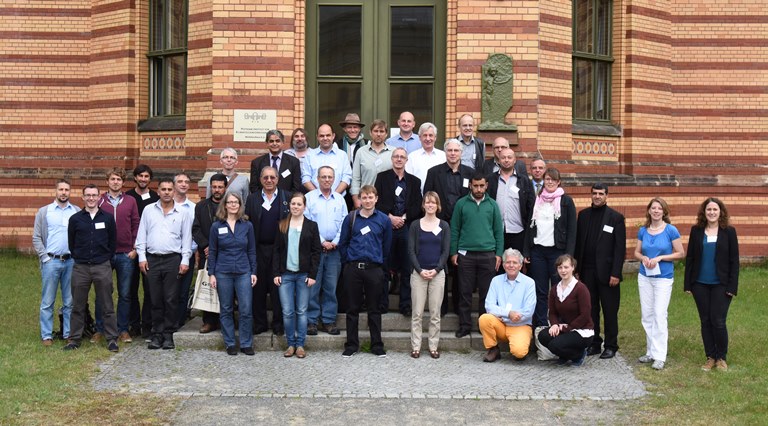
Participants of the Second DESERVE Science Progress Meeting.
23 talks provided an insight into already accomplished research activities complementing long-term measurements of climatic, hydrological, and tectonic processes by extensive field campaigns (sinkhole campaigns, HEADS 2014, seismic wind array etc.) and modelling studies (COSMO-ART, J2000g etc.). The talks emphasised and demonstrated the high potential of applying recently developed measurement and modelling techniques to the extreme conditions of the Dead Sea.
The very productive event in a cordial atmosphere clearly showed the scientific progress and the good relations within DESERVE. It also demonstrated the high demand for an integrated approach of earth and atmospheric sciences as achieved with DESERVE to cope with the outstanding challenges - environmental risks, water availability and climate change - in the Dead Sea region.
New publication: Water quality and discharge of the Lower Jordan River
New publication: Water quality and discharge of the Lower Jordan River
Noa Hillel (Ben-Gurion University of the Negev) et al. monitor and analyze water quality and discharge of the Lower Jordan River. The fresh surface water of the Lower Jordan River (LJR) has been limited in the past several decades due to damming of its main tributaries, which reduced the annual flow by 90 %, leaving a mixed flow of polluted and saline sources. A monitoring and sampling hydrometric station was installed on the southern LJR to track the temporal variations of its discharge and hydrochemistry. In addition to manual water sampling, the station includes an automatic water sampler and cellular transmitting pressure and EC sensors, allowing real time observation. All samples were analyzed for major ions and several samples were analyzed for selected isotopes (34Ssulfate, 18Osulfate, 15Nnitrate, 18Onitrate, 2Hwater, 18Owater) as tracers. A general inverse seasonal trend was found between EC and water level although extreme values relate to flood events during the wet period. A presence of water from the saline drainage carrier was detected using major ion ratios. Isotope analyses reveal lithology and sewage as the respective major contributors of salinity; they were used to identify events unrelated to runoff (i.e., to precipitation in the area). It was concluded that continuous monitoring is required for understanding the long-term hydrochemical situation, especially during extreme events which occur infrequently, but may have a drastic effect on fauna and flora.
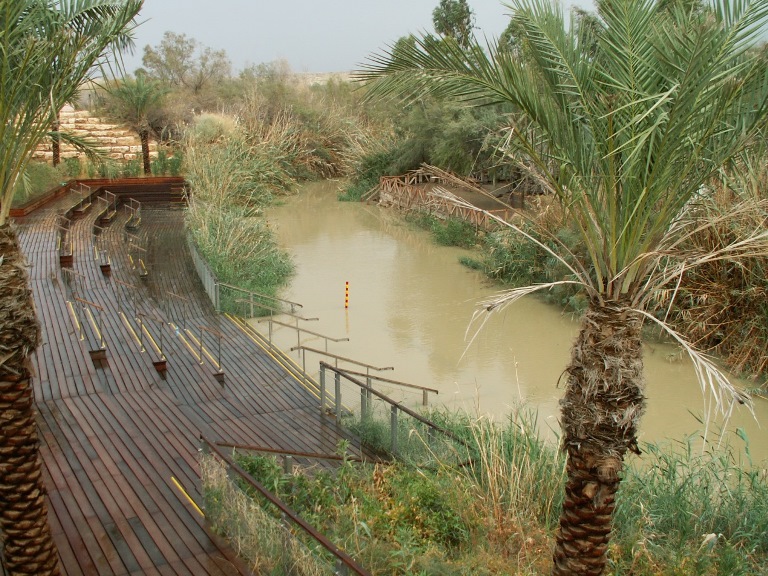
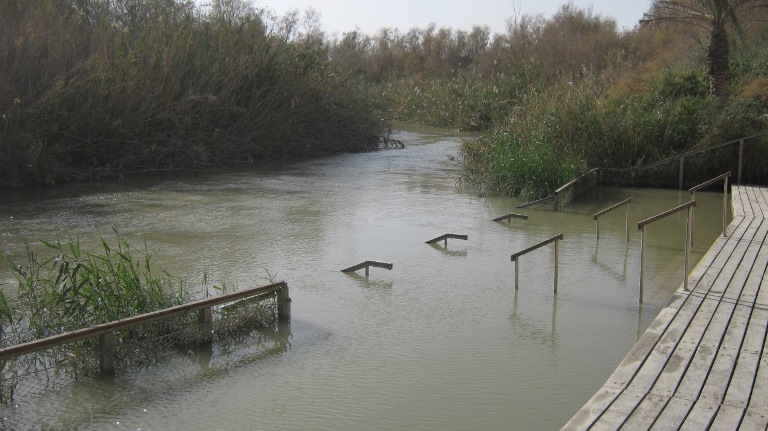
The full article is published in Journal of Hydrology:
Hillel, N., Geyer, S., Licha, T., Khayat, S., Laronne, J.B., Siebert, S., 2015, Water quality and discharge of the Lower Jordan River, Journal of Hydrology 527: 1096–1105, http://dx.doi.org/10.1016/j.jhydrol.2015.06.002.
Picture gallery: Sinkholes
Picture gallery: Sinkholes
A selection of impressive photographs of the sinkhole field campaign in Jordan last year has just been published online by the biggest German weekly newspaper ‘Die Zeit’. Have a look on the pictures here.
The photographs were taken by Djamil Al-Halbouni, PhD student within DESERVE (GFZ), and Eoghan Holohan (GFZ).
In the recent past, DESERVE has gained lots of attention in the media. A list of articles published in the framework of DESERVE can be found here.
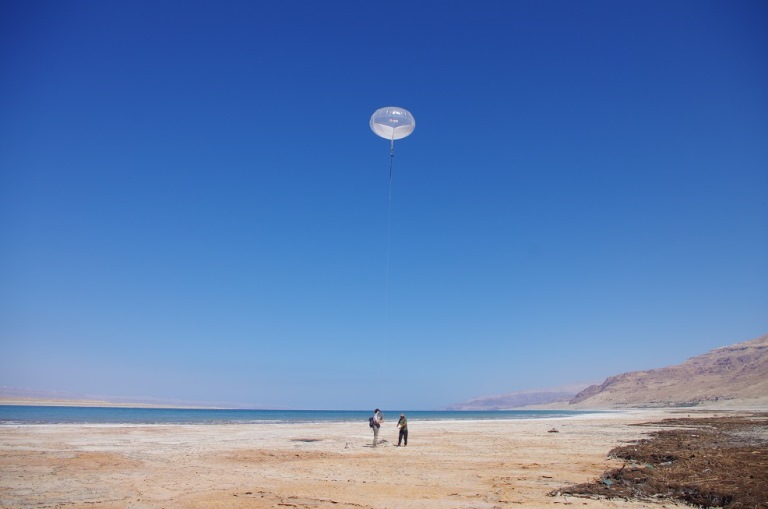
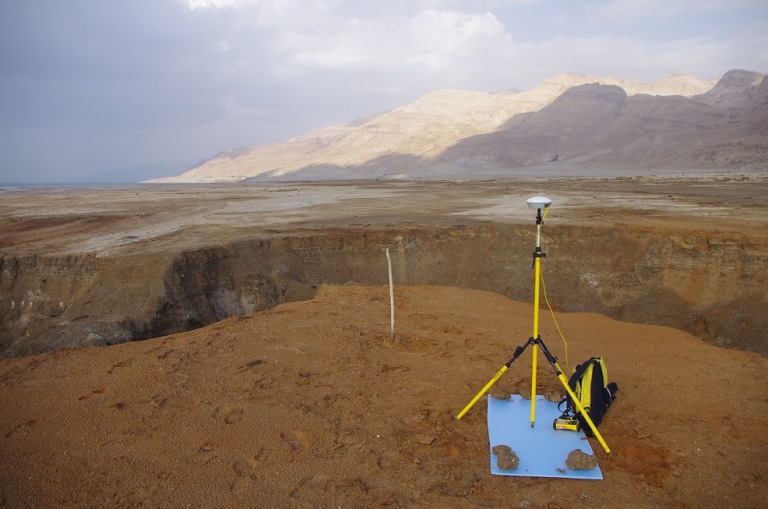
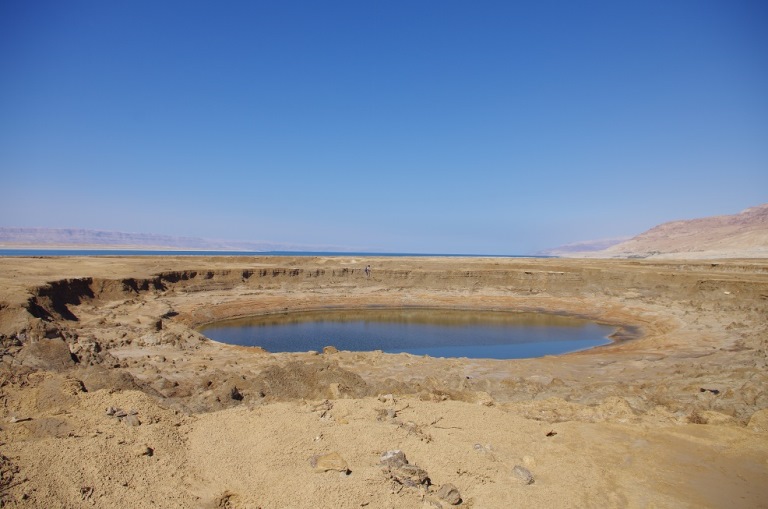
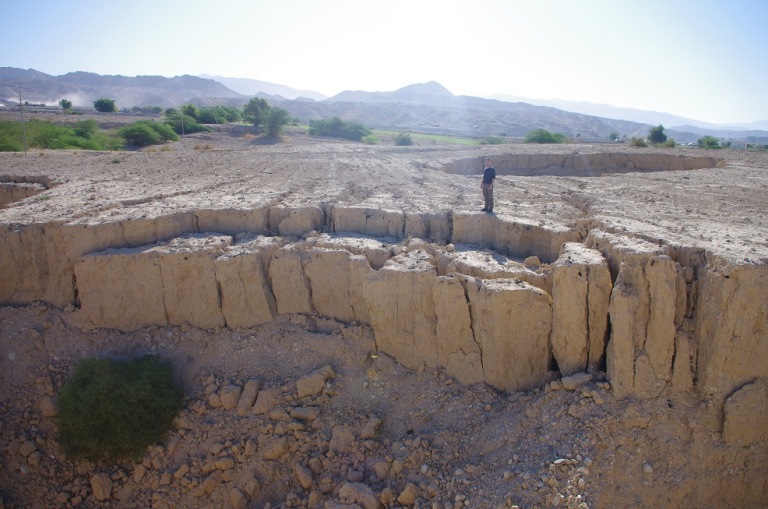
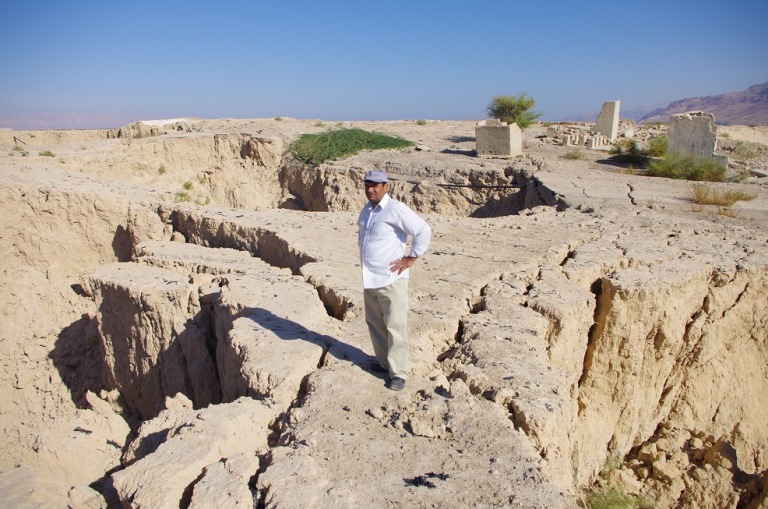
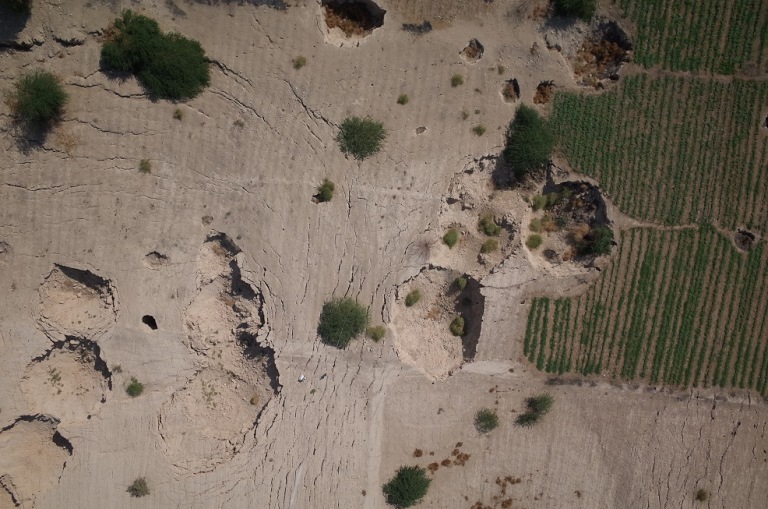
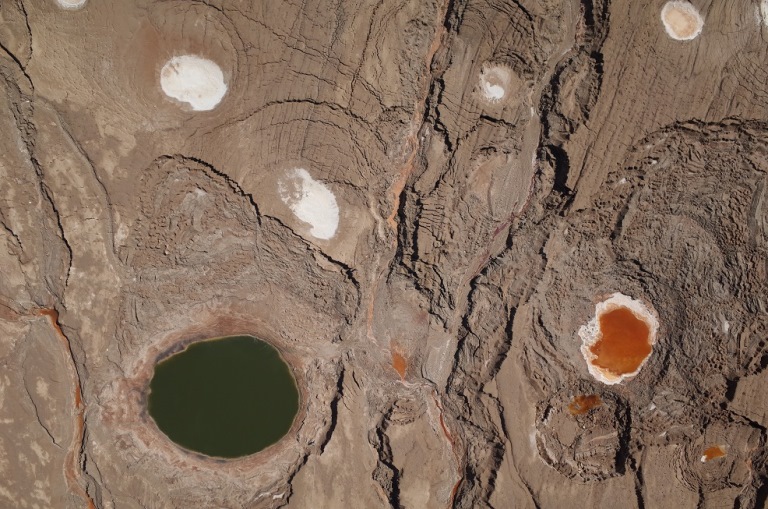
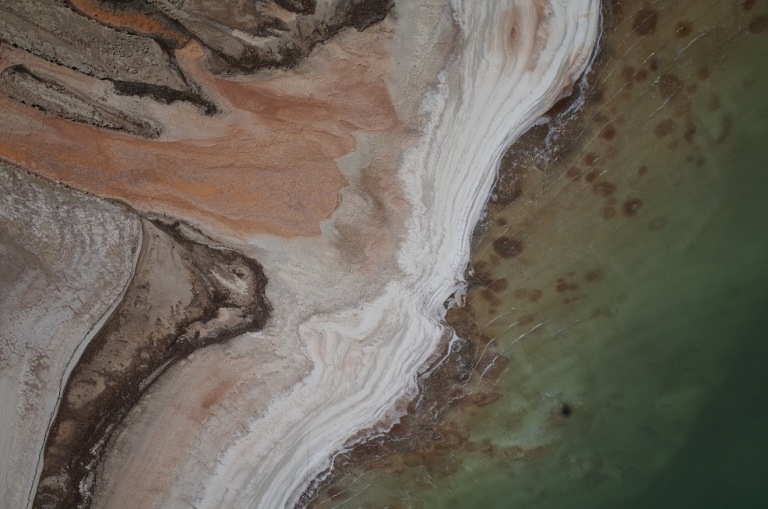
Sinkholes: 2015 field campaign in Jordan successfully completed
Sinkholes: 2015 field campaign in Jordan successfully completed
DESERVE members from the Ministry of Energy and Mineral Resources (MEMR, Jordan) and the German Research Centre for Geosciences (GFZ, Germany) successfully carried out field measurements at the Ghor Al Haditha sinkhole site in Jordan. The focus of this years’ research was on aerial photography, field observations as well as water sampling.
Aerial photography combined a helium filled Helikite Balloon with a Quadrocopter survey. By doing so, more than twice of the area of 2014 was investigated. The goals are to detect changes in the topography, to detect sinkhole collapse precursors such as small subsidence and submarine features as well as to create a large high resolution digital elevation model (DEM) including the northern part which is the most active sinkhole area.
For a detailed analysis on the role of subsurface water flow in sinkhole formation, a water level and a water sampling analysis have been undertaken. Fortunately, due to stormy weather, sinkhole as well as spring and canyon formation could be directly observed in the mud during the two weeks of field work. All in all, a successful survey with unexpected impressive observations.
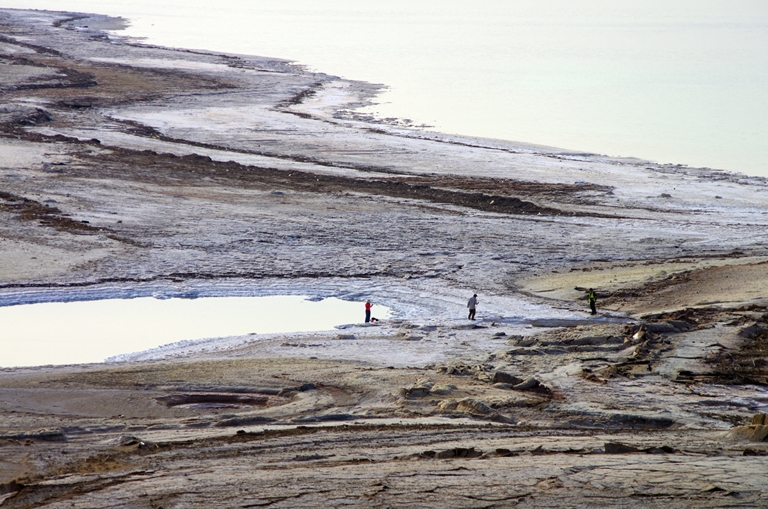
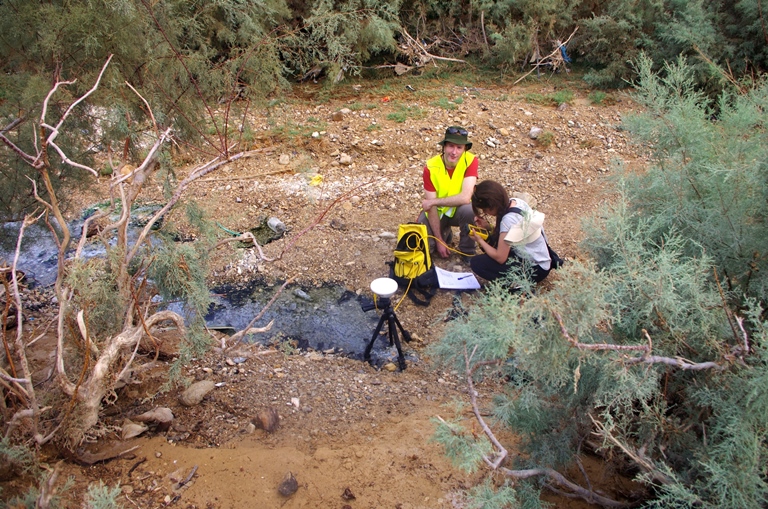
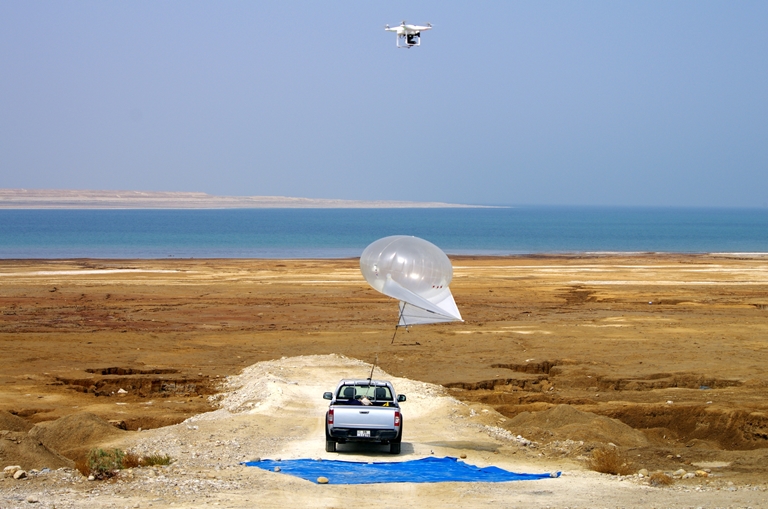
DESERVE Weather Friendship: Training courses
DESERVE Weather Friendship: Training courses
To train local teachers on the use of the meteorological data gained by the DESERVE Weather Friendship, members of the IMK-TRO at KIT visited the Palestinian and Israeli schools of the DESERVE Weather Friendship.
In total, 25 teachers participated in four training courses that were based on the meteorological measurement data of the schools participating in the DESERVE Weather Friendship. Diversified examples and exercises illustrated prominent meteorological phenomena in the Dead Sea region such as the land-sea breeze. Moreover, the participants were taught in the calculation of monthly sums, averages and extreme values of e.g. temperature and precipitation, with the help of the online visualization tool of the measurement stations. First, data were evaluated for their own school weather station. Second, results were compared to the meteorological data of the other schools of the DESERVE Weather Friendship and differences have been interpreted.
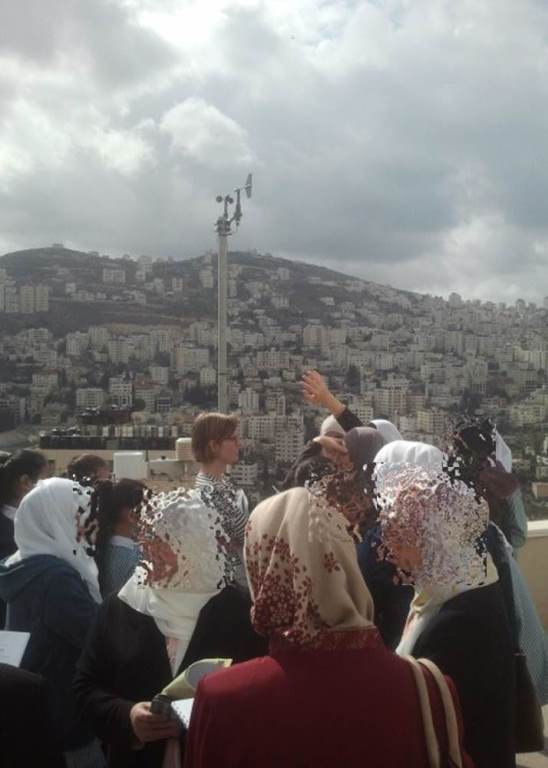
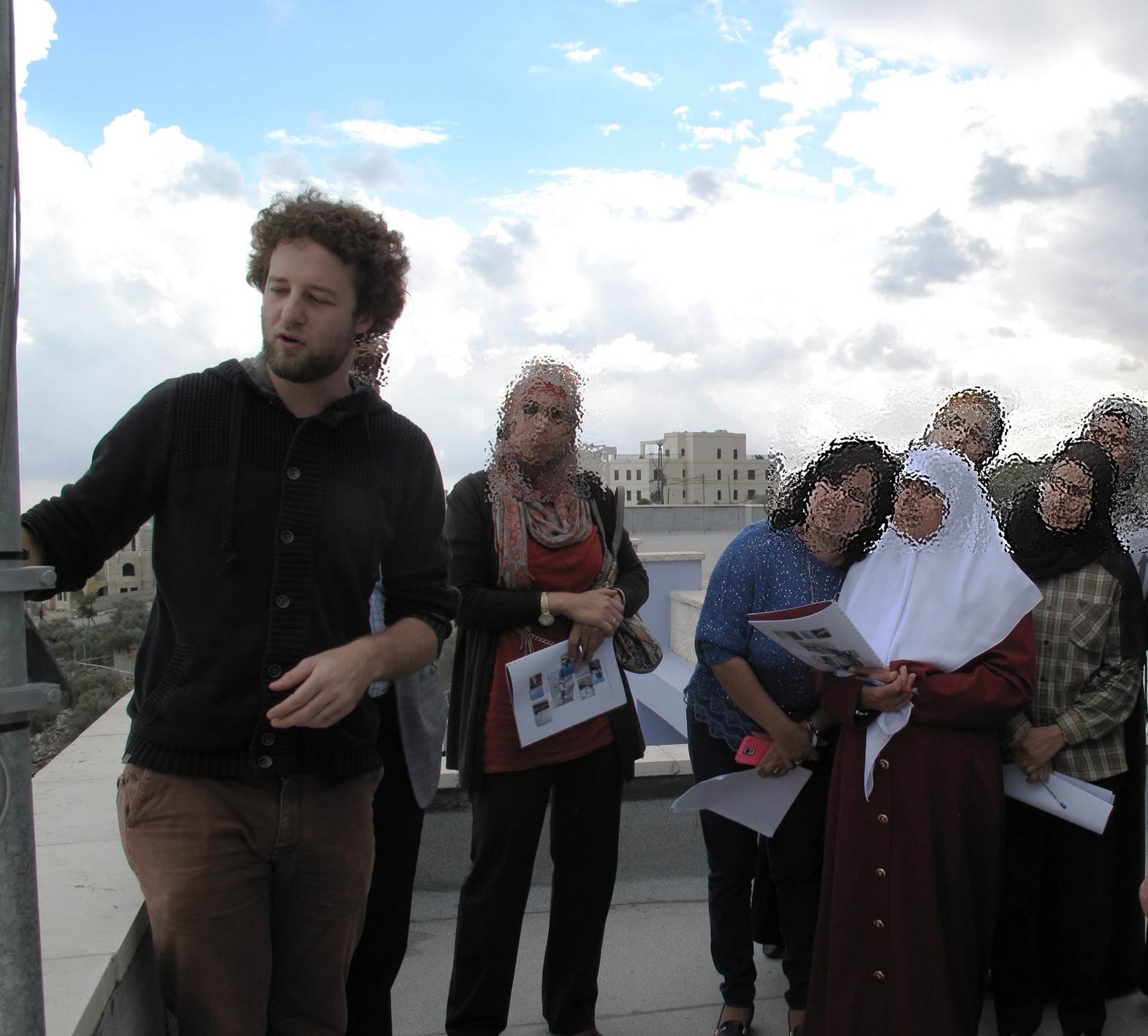
Similar courses are foreseen at the Jordanian schools participating in the DESERVE Weather Friendship in early 2016.
The DESERVE Weather Friendship is a transboundary meteorological monitoring network at schools in the Dead Sea area. At present, two school weather stations are installed in Israel, Jordan, and Palestine respectively. By collecting and analyzing their own weather data, the children learn about the weather in their region. Each hour, current weather data such as air temperature, wind direction, wind speed, and rainfall are automatically transferred to an online available visualization tool. The children can access the measurements of their own meteorological station as well as the measurements of the other schools participating in the DESERVE Weather Friendship.
Meteorological monitoring network around the Dead Sea
Meteorological monitoring network around the Dead Sea
In cooperation with local partners, a network of meteorological stations is established around the Dead Sea in Israel, Palestine and Jordan. Up to seven stations record data on the current weather conditions and on evaporation in the Dead Sea region.
The meteorological station at Masada (Israel) is already operating since 2006. In spring 2014, the meteorological station at Panoramic Complex (Jordan) and 3 fully equipped energy balance stations (EBS) were build up. One EBS was erected at the shore line of the open Dead Sea (Ein Gedi Beach), one over bare soil (Ein Gedi Spa) and one within vegetation (Kane). The EBS measure the complete energy balance of a surface with high frequency and precision. The first meteorological station in Palestine (Auja) was build up in November 2014.
In October 2015, the EBS Kane was moved by members of the IMK-TRO at KIT to a dike within the evaporation ponds near Ein Boqeq. The aim is to get information on evaporation from different water surfaces (open Dead Sea water vs. evaporation ponds) under different weather conditions. As all stations are equally equipped a comparison of pan to lake evaporation is also possible.
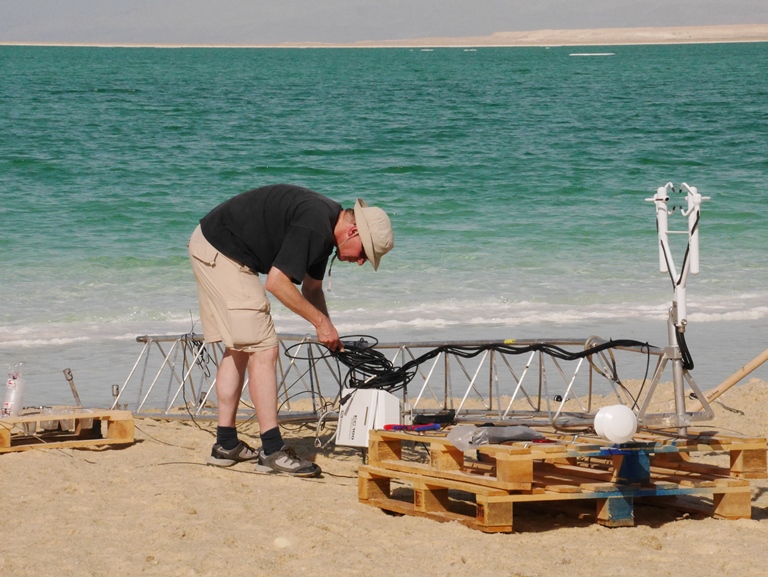
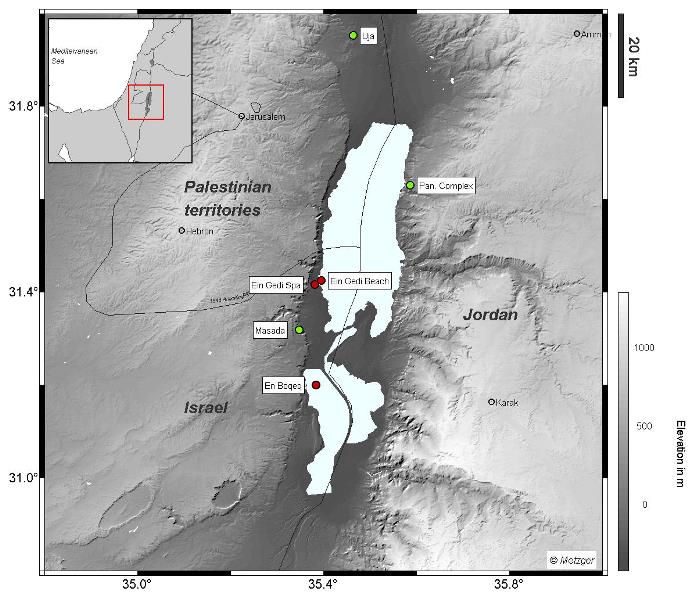
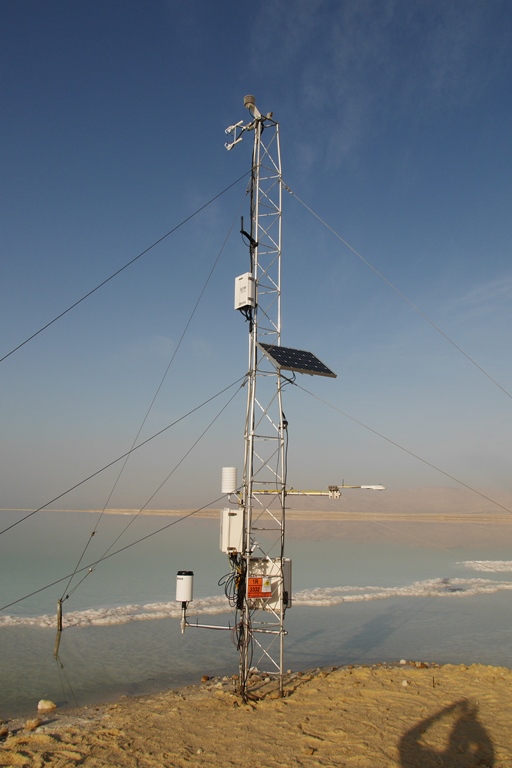
New publication: New perspectives on interdisciplinary earth science at the Dead Sea: The DESERVE project
New publication: New perspectives on interdisciplinary earth science at the Dead Sea: The DESERVE project
DESERVE scientists have published an overview paper on the DESERVE project in Science of the Total Environment.
"The Dead Sea region has faced substantial environmental challenges in recent decades, including water resource scarcity, ~ 1 m annual decreases in the water level, sinkhole development, ascending-brine freshwater pollution, and seismic disturbance risks. Natural processes are significantly affected by human interference as well as by climate change and tectonic developments over the long term. To get a deep understanding of processes and their interactions, innovative scientific approaches that integrate disciplinary research and education are required. The research project DESERVE (Helmholtz Virtual Institute Dead Sea Research Venue) addresses these challenges in an interdisciplinary approach that includes geophysics, hydrology, and meteorology. The project is implemented by a consortium of scientific institutions in neighboring countries of the Dead Sea (Israel, Jordan, Palestine Territories) and participating German Helmholtz Centres (KIT, GFZ, UFZ). A new monitoring network of meteorological, hydrological, and seismic/geodynamic stations has been established, and extensive field research and numerical simulations have been undertaken. For the first time, innovative measurement and modeling techniques have been applied to the extreme conditions of the Dead Sea and its surroundings. The preliminary results show the potential of these methods. First time ever performed eddy covariance measurements give insight into the governing factors of Dead Sea evaporation. High-resolution bathymetric investigations reveal a strong correlation between submarine springs and neo-tectonic patterns. Based on detailed studies of stratigraphy and borehole information, the extension of the subsurface drainage basin of the Dead Sea is now reliably estimated. Originality has been achieved in monitoring flash floods in an arid basin at its outlet and simultaneously in tributaries, supplemented by spatio-temporal rainfall data. Low-altitude, high resolution photogrammetry, allied to satellite image analysis and to geophysical surveys (e.g. shear-wave reflections) has enabled a more detailed characterization of sinkhole morphology and temporal development and the possible subsurface controls thereon. All the above listed efforts and scientific results take place with the interdisciplinary education of young scientists. They are invited to attend joint thematic workshops and winter schools as well as to participate in field experiments" (Kottmeier et al., 2016).
WP 5: Panoramic camera surveys completed
WP 5: Panoramic camera surveys completed
The final four omni-directional camera surveys, using the GFZ MoMa (Mobile Mapping) system, have been completed within the week from 26th June - 1st July in Israel and Palestine. With the great support of Jalal al Dabeek, Wala Ajaj and Ayman Mohsen from the An-Najah National University and Safaa Aldwaik and Husam Jada from the municipality of Ramallah, two surveys in Nablus and Ramallah were conducted taking over 130,000 geocoded panoramic images of the building stock.
With the great support of Tsafrir Levi and Jakob Rafael from the Geological Survey of Israel, we completed two campaigns in the cities of Eilat and Tiberias, where more than 90,000 images were collected. T. Levi introduced us to the geological situation and features around Eilat and Tiberias during short field excursions.
The collected data will now be analyzed with the help of local engineers using a web-application, recently developed at the German Research Centre for Geosciences, Potsdam for crowd sourced exposure modeling. The obtained information will be used to estimate the seismic risk in all locations selected within the DESERVE project: Eilat, Kerak, Madaba, Nablus, Ramallah, and Tiberias.
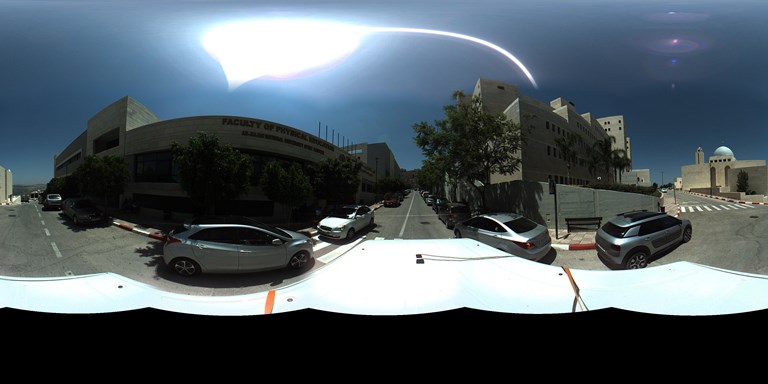
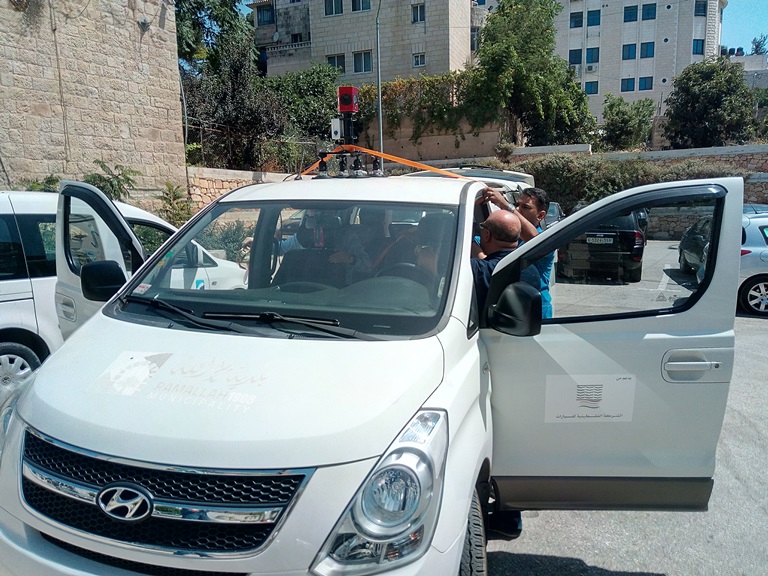
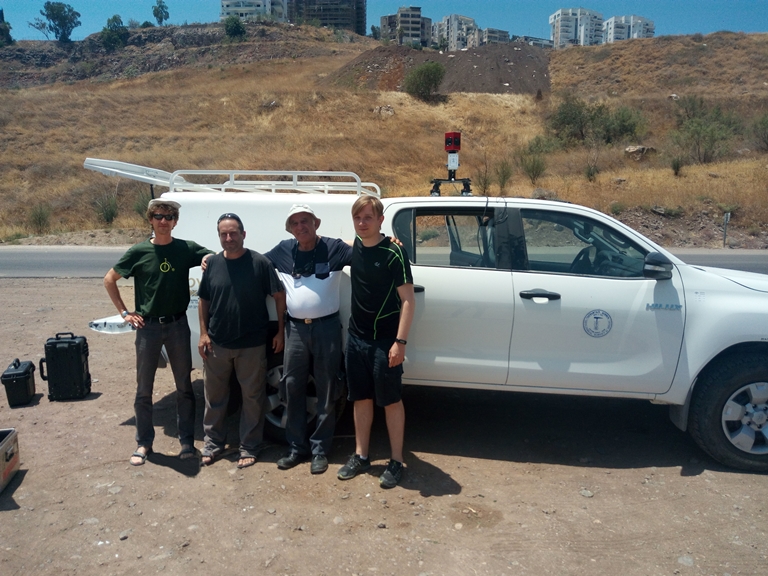
Thanks a lot to all people who devoted their time to this cross boarder campaign, also to Ali Sawarieh and Mahmoud al-Qaryouti from the Ministry of Energy and Mineral Resources in Jordan (surveys in Madaba and Kerak, August 2015), and all who made it possible to gather data for all three adjacent territories, acknowledging the fact that an earthquake doesn't ask for the passport.
Involved Researchers:
In Israel: T.Levi, J.Rafael
In Jordan: M.Al-Qaryouti, A. Sawarieh
In Palestine: J. Al-Dabbeek, W. Ajaj, H. Jada, S. Aldwaik
Second DESERVE Winter School
Second DESERVE Winter School
The Dead Sea Research Venue hosted the second DESERVE Winter School at Madaba (Jordan) from 4 to 15 December 2016. DESERVE welcomed 25 students from universities and research institutions, in particular Master and PhD students, with manifold educational background ranging from geophysics to hydrology and meteorology and common interest in the Dead Sea region.
The Winter School focused on sinkholes, seismicity, and hydrogeology in the Dead Sea region. It was opened with a science slam where each participant presented his/her research in an entertaining way, only with the help of a self-drawn picture. At temperatures still above 20°C, the participants applied photogrammetry, electromagnetics and shear-wave reflection seismics to characterize sinkhole areas and processed the collected data afterwards. They were very lucky in experiencing the arrival of a flash flood and measuring its discharge. All field days were accompanied by lectures and exercises given by internationally recognized researchers of the DESERVE community. The lectures and exercises included the basic concepts of the estimation of discharge and groundwater age, sinkhole development and characterization methods, seismic rupture and waves, earthquake location, magnitude, moment and displacement, as well as the basic concepts of seismic hazard assessment. The Winter School was closed with a farewell dinner.
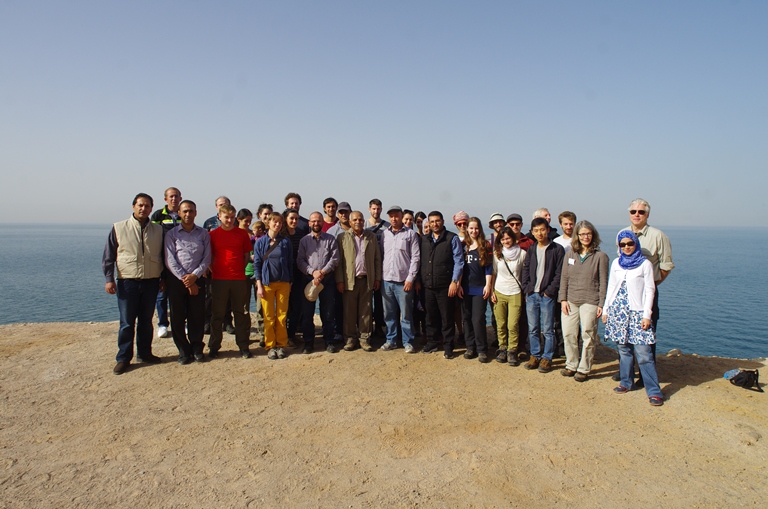
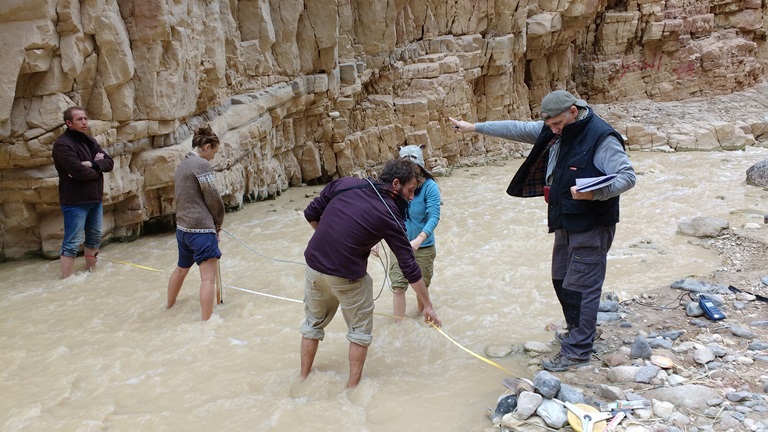
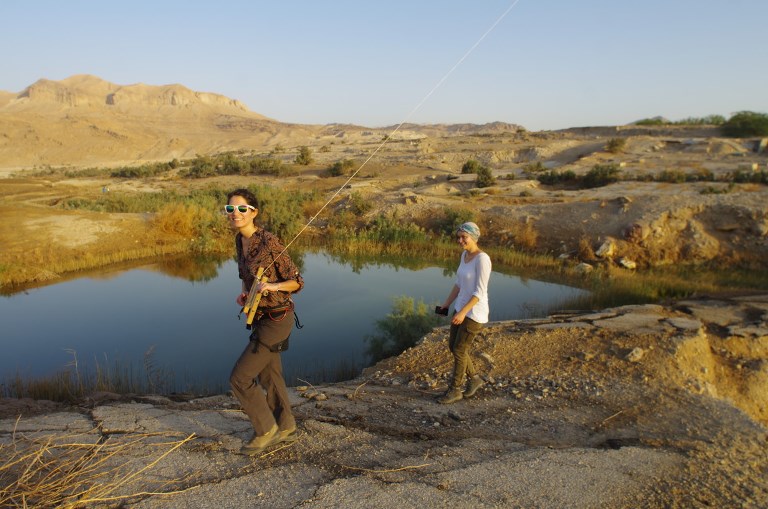
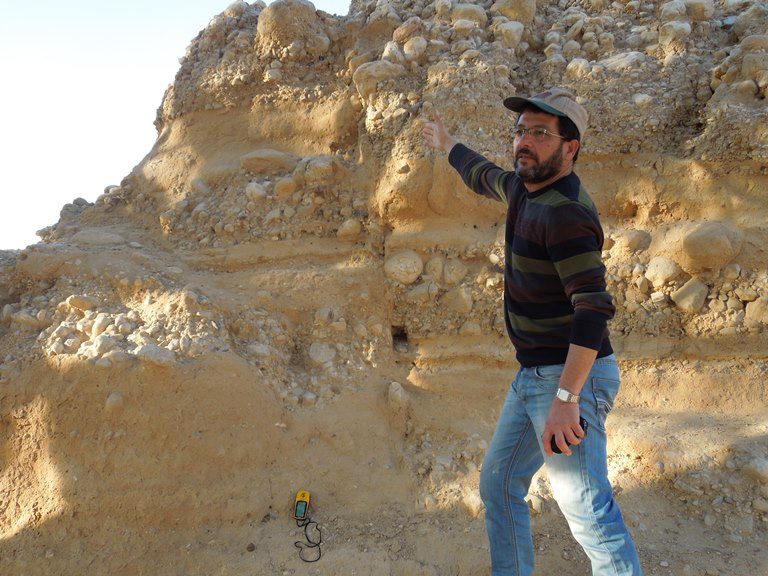
The participants’ feedback was very positive. DESERVE is pleased that the Winter School brought forward their research as well as contributed to the scientific exchange within and among the different disciplines. There was a great atmosphere among the students. They enjoyed their stay, had a lot of fun and made new friends.
“It totally went beyond my expectations. It was a great opportunity and it was really important to meet people from different backgrounds.”(Feedback of one participant)
DESERVE would like to thank all lecturers for sharing their knowledge and experience. An event like the Winter School would not be possible without their support. A special thanks goes to the motivated participants of the DESERVE Winter School. Thank you very much for your participation and your active contribution in this event. It was a great pleasure to host you at Madaba.
